#or just change my politics and expand the blog theme
Explore tagged Tumblr posts
Text
I’m running out of submissions 😔
#mod rambles#okay I need to either get my creativity spin and come up with some sort of extra activity on this blog#or just change my politics and expand the blog theme#but I also have eight (I think) characters in my drafts whom I found myself#so I’m fine#ajdnkfkf
1 note
·
View note
Note
oh good i didn't know this blog existed and i need to get something off my chest and it's that 3h fucking sucks because it doesn't actually want to commit to half of its themes. between the gross white savior-y shit going on with dimitri and duscur, petra just being ok with her country essentially being absorbed into adrestia because the plot demands it and. fucking almyra. in general. but because it half commits to saying racism is bad and has that ingrid/dedue support and has enough characters simply say "discrimination is bad actually" then idk the fandom just kind of overlooks all the other shit the game DOES and excuses it because claude wants to end racism.
and i don't think the game having 4 routes with separate viewpoints and "well that's so much writing think of the writers" excuses that actually. this is an exceedingly political game, you either commit to your fucking themes or you make a different game. one route is a good 80 hours long and there are so many cutscenes. you're telling me they couldn't fit in actually showing how racism is a systemic problem but could fit in half the cast just saying that? or who knows, maybe it actually is in the game and i just missed some bonus monastery text in the latter half of golden wind. which like. that isn't good. that should be main story shit, not relegated to optional and probably faceless, unnamed npcs.
or, and this one is loaded, the game actually fucking loves bloodlines. it doesn't like crests, yes, but it loves families. you have all these characters with fucked siblings and abusive parents but ohh that's family you HAVE to love them. the fact miklan gets a fucking redemption arc in hopes genuinely pisses me off. why is it that miklan, who repeatedly abused and has attempted to kill sylvain (who i don't even like!!), pillages villages, and is the leader of a whole ass infamous gang of bandits is framed in more of a sympathetic light than fucking rhea? why are we handwaving the shit that he does away because he's sylvain's brother and well he's kind of loyal and surprisingly a good leader? shut the fuck up. i understand that people can change but these are effectively 2 different people now. you have the irredeemable piece of shit from houses and now the flawed and tragic, but sympathetic miklan in hopes. these two fundamentally cannot coexist and yet the game wants you to pretend they can.
it's even worse because houses tells you margrave gautier disowns him whereas hopes tells you miklan left of his own volition. you are rewriting your own canon here. i suppose one of them could be lying, but what does that say about the situation? and what do either of them even have to gain from lying?
oh god and the complete refusal to expand on count varley. he's characterized in houses as being cruel and so incredibly abusive, but Unfortunately competent. hopes just makes him comic relief. like. are you fucking with me right now? am i being played? is this an elaborate hoax? i don't know anymore. you can have him be a sniveling little coward, but to play his behavior off as a joke and just go "eh you can kill him later bernie :)" is just. why. houses already fumbles bernadetta and this just feels like they're doubling down on it.
i dunno. whatever. i don't really care if this sounds like i'm cherrypicking but this game isn't fucking well-written or even particularly intelligent. it's politically shallow and the fact people think it's well-written still baffles me to this day. it's probably because whatever headcanons people are coming up with to fill in and justify all the stupid bullshit are infinitely more interesting than whatever the game actually has to say.
anyway uhh. edelgard mention. to check the last required box of 3h discourse.
-
3 notes
·
View notes
Note
If you have any worldbuilding ideas for any games you like i would like to hear them. Sits politely.
Generally, I try to keep stuff like that relegated to my own personal fan projects, just because I vastly prefer the wiggle room that provides. I don’t really like making major changes to canon like that, and just projecting that image onto the actual work itself. There’s a weird pressure that comes with that for me. If I have things stacked into a fanwork, that looks less like I’m wrong, and more like I’m vibing.
Analysis is a different beast. Though sometimes one must take a little bit of artistic liberties in an essay, I generally just extrapolate upon what’s already there. I try not to lose the plot too badly, though, lol. I like to think I just amplify parts of the text that are already there, and tend to keep things character focused. Such as my various analyses on “aberrant” sexuality in Pikmin, and how that ties back to the very heavy criticism of harsh, restrictive societal expectation and capitalism present in the series. And also my entire Homestuck blog.
I had a couple really eloquent paragraphs written about this previously, but Tumblr deleted all of them, so you get that instead. Lol.
That said… here’s some sloppy brief overview notes. Could definitely expand upon these, if there’s any interest.
In Graveyard Broadcast, my Splatoon “rewrite” project, the Octarian Military is structured in a specific funny way that makes “General” not be the Top Dog. The top dog is the Shōgun King, which is Octavio. Turf War is a propaganda tool, a surface-dweller having a relationship with an Octarian is seen as bedding the enemy, and you can get charged with treason for it. The segregation is enforced with laws and lethal force. The surface is extremely intensely militarized, yet has such impressive PR through its deeply intense levels of consumerism that hardly anyone even realizes they’re living in a military state.
Haven’t named my Pikmin fanworks yet somehow, but a lot of my worldbuilding is just compounding the already present themes. Hocotate is a deeply conservative hellish desert planet that is deeply intolerant of anything that dares to diverge from the norm. Yes, there are individuals who are chill, but the overall culture is pretty oppressive. No one’s truly happy under this system, not even those who fit the exact mold society wants them to fit in. I’ve also got a lot of Spec Bio. Pikmin is basically begging on its hands and knees for you to do Spec Bio at it given some of the weird lore it gives you, and the literal amateur xenobiologist main character, so I’m taking that bait. That’s not what you’re asking for, though, so… That’s for another day.
4 notes
·
View notes
Text
Little page update + small intro
I plan on being more active
Hi guys so if you know me on TikTok (@Flytric) then you’ve probably already seen that I’ve primarily shifted away from Marble Hornets/Creepypasta and I’ve shifted more towards Zero day (2003). This doesn’t mean I’ve left the fandom, I still interact with crp/mh content and I’m still semi active in the fandom, it’s simply that I’ve taken a higher interest in Zero Day. I’ve finally decided to make that same shift for my tumblr as well since I’ve had my blog themed as marble hornets (particularly Alex Kralie) probably ever since I made this account in march of 2024 (I think that’s when I started this account??) and I’m getting a bit tired of it. With this theme change, I also plan to be more active. Previously, I was a bit nervous to post on tumblr as I was sort of new to it and I’m extremely socially awkward as well as being self conscious about what I post. However, with summer approaching I’ll have more time to post and I’ve decided to try and overcome this anxiety, therefore I’ll be posting more on here (as well as hopefully on TikTok) in hopes of doing just that.
What do I plan to post?
My first plan is color coordinated zero day pfps (from the movie + making of) paired with complimentary/matching hex codes, from there I plan on expanding out to other fandoms such as ones mentioned in my intro or even taking requests.
Shit posting is a guarantee ❤️
Short and quick intro
Hi I’m Cole (14)
I follow back for the most part and if I don’t then don’t take it personally (I probably just didn’t see the notification)
Fandoms I’m in/interests:
Zero day (2003), Elephant (2003), The Eltingville Club, Creepypasta/Marble hornets, Lucky Star, Royale high (Roblox), ^_^ (Roblox), Let him go (Roblox), To the bone (2017), & way more (feel free to ask if I’m in your fandom 👅👅)
Boundaries/DNI
I don’t really have a DNI, if I don’t like you or your content I just won’t interact. No MAGA or highly political pages preferably.
Thank you for your time if you read

#zero day#zero day 2003#I love Andre Kriegman#Flytric#creepypasta#marble hornets#if you recognize me from TikTok moot up#I don’t know how to tag
1 note
·
View note
Text
Looking at my blog now, it's truly amazing to reflect on how much it has changed and grown over time. What initially began as a simple assignment for university, with the goal of sharing my thoughts on contemporary art, has transformed into something far more multifaceted than I ever imagined. It has evolved into a place where I virw contemporary art from new perspectives, and engage with art in ways that I never anticipated when I first started this blog . What began as a straightforward task has gradually become something that genuinely engages me.
The process of developing this blog has been one of trial and error. Some things have worked brilliantly, while others have fallen flat, but through all of it, I've been able to refine my voice and hone my approach. I've learned a lot about writing and curating content.
One post that stands out to me is my post about Egle Rakauskaite. I find myself particularly proud of how that post came together, as it allowed me to dive deeply into the complexities of the artist’s work. Rakauskaite's ability to weave intricate themes of identity and place into her pieces left me fascinated, and I was thrilled to share that passion with my (most likely non-existent) readers. I feel that each post I've written has contributed in some way to my understanding of contemporary art, providing a glimpse into various aspects of the field that go beyond just the visual. My blog has allowed me to explore art in a way that intersects with the social, political, and emotional realms in art.
For instance, my visit to The Royal Standard was a pivotal moment. It helped to reinforce my belief in the importance of nurturing emerging artists and providing them with ideas. Contemporary art thrives when there are spaces that encourage exploration and risk-taking. That visit reminded me how vital it is to support new voices, as they bring fresh ideas that can challenge conventional thinking and offer new perspectives. This is a theme I’m eager to continue exploring in my future posts. It was also very interesting visiting where art is made, usually the process of creation, and the result seems very separate.
Another significant influence on my writing has been Katy Morrisons from Pink Manchester's lecture, which emphasized the power of art as a tool for advocacy, particularly in marginalized communities. The idea that art can be a vehicle for social change and empowerment resonated deeply with me. I’ve seen how art can serve as a powerful commentary on social issues, and I’m excited to delve deeper into this aspect of contemporary art in future posts. In particular, I’ve been inspired by the work of artists who use their practice to address political and social injustices, and I plan to explore more of this in my blog.
Ultimately, I’ve come to realize that contemporary art is about much more than just aesthetics or being pretentiou. It acts as a space where conversations are sparked, identitys are explored, and transformation takes place. Each post I write has helped me explore how art intersects with different aspects of human experience, and the act of sharing these ideas has enriched my own understanding of the art world. Writing about contemporary art has become a way for me to engage with the world in a deeper, more meaningful way, and I look forward to continuing this.
As I reflect on where my blog stands now, I’m filled with excitement about what’s next. There are so many artists I want to explore, particularly international artists whose work challenges cultural boundaries and expands the conversation around art and identity. I’m also eager to explore local artists and provide them with a platform to share their voices. The possibilities for future posts are endless, and I can’t wait to continue evolving this blog alongside my own growth as a writer and art enthusiast. The blog has become more than just an academic piece. It now involves me developing a genuine interest in contemporary art that I never thought I'd have being someone who really really likes Medieval art, for example. journey. I hope this blog will continue to inspire me and evolve in exciting new ways. I look forward to where this journey will take me, and I can't wait to see what’s next.
(To continue the theme of every post having pictures have some pictures of the family Kitten Donaldas)




0 notes
Note

Commented but there's a limit and now I'll feel bad if I don't expand on why I feel this way. Again I'm not saying 'throw the whole ask out' but I do think it would be an asshole move of me to just drop this on my best friend's blog with such nebulous wording then walk away.
Phrases like:
"harder for someone who isn't in the know to recognize how the underlying message [] reflects on society"
...are nearly identical to arguments used to justify censorship of fanfiction, erotica, and queer/trans narratives under the guise of “protecting” vulnerable readers. This assumes that audiences, especially young or marginalized ones, are incapable of consuming or critically engaging with challenging material, and it places the blame for societal harms on fictional media, rather than the real systems that make those harms possible.
This is particularly dangerous when talking about kink, erotica, and identity play, especially in queer/trans spaces, where fiction is often one of the only tools available to safely explore things like dysphoria, social coercion, or taboo desires.
The entire ask tends to conflate depiction with endorsement, treating the existence of certain tropes (noncon, pregnancy, social coercion, dubcon, etc.) as necessarily pushing a worldview rather than engaging with them as fantasy. That’s a slippery slope toward moral purity politics. When they say:
"conversion therapy for the transmasculinized subject"
That’s not a neutral critique. it’s a deeply inflammatory metaphor that equates narrative arcs involving submission, identity, or emotional change with real-world abuse. That implies that engaging with certain fantasies is inherently harmful or internalized oppression, which pathologizes the people who enjoy them.
It also strips agency from readers (especially transmasc readers), implying that we are too naive to understand what we’re reading, or that exploring "wrong" feelings is dangerous. That’s exactly the logic used to gatekeep what kinds of trans narratives are “acceptable” in publishing, media, and online spaces.
This part stands out:
"Again, nothing inherently immoral, but..."
That “but” is doing a lot of work. They're trying to have it both ways, saying “I'm not moralizing,” while still expressing anxiety about what fiction might say to others, especially if it doesn't present a clear or "progressive" message. This is textbook moral panic territory.
Erotica {and especially erotic fiction created by queer and trans people} has always lived in the space between fantasy and transgression. It’s not supposed to conform to social ideals. It doesn’t owe moral clarity. Its very purpose is to explore things that don’t have clean answers. Demanding that it be politically correct in-universe is just another form of control.
And this:
"hope younger readers know that it's for entertainment"
implies that younger readers are too stupid or impressionable to recognize fantasy, or that older readers are responsible for “protecting” them from complex themes. This framing is ironically paternalistic, and it’s been used time and time again to suppress queer fiction, especially around themes like noncon, kink, or gender.
This also dangerously flattens the fact that many of the people writing and reading these works are the people with lived experience of marginalization, trauma, and queerness.
So in short, I am alarmed because:
They’re using the exact rhetorical structure of moral panic while claiming neutrality.
They are pathologizing desire (particularly transmasc-coded desire).
They are prioritizing social legibility over community exploration of fantasy.
They are dangerously close to advocating for censorship, even if they don’t realize it.
One of the things about omegaverse is that oftentimes it might be radical from our pov, but the key thing, to me at least, is how it presents it's rules in universe. Like the idea of men being submissive or transmasculinised etc is not mainstream irl, but in so many works I have seen the rules that are established in universe treat biology as king and basically codify gender essentialism into bioessentialism. Like traits associated with femininity are often biologised as "omega instincts" often instincts to be submissive/ homemakers/etc. And vice versa. It takes a lot of the social aspects of gender and turns them into biological traits as a cornerstone of the au.
The amount of fics I've read where paternalism is actively campaigned for as part of the narrative as a necessary aspect of society to protect the weaker sex? All I can do is hope that younger readers know that it's for entertainment and have a solid enough sense of self to detach the messages from their own world view. (To say nothing of the prevalence of narratively approved corrective rape fic of a specifically gendered bent. Again, nothing inherently immoral, but when you muddy the waters, it's harder for some who isn't in the know to recognize how the underlying message of "this person had dubiously consensual sex(/learned to like it) with someone of a minoritised sex/gender and now they are conforming to social expectations of their gender and are happier for it" reflects on society)
I have no true distaste for the genre and read it occasionally even when the narrative is basically conversion therapy for the transmasculinised subject because I don't think choices in fiction reflect my beliefs, and I think there are benefits that come from cis people being exposed to a man who is not a cis man, but I don't think that it is fair to ignore the trends in a lot of the works that parallel real life transandrophobia and bioessentialism. Bioessentialism and misogyny are still bioessentialism and misogyny when happening to men, even fictional men who aren't trans by the rules of their universe
yeah people just have to be aware of things
117 notes
·
View notes
Text

ABOUT THE BLOG ⸻ low activity due to my work as an attorney. mostly active in the evenings and weekends, but generally available on discord for plotting and ooc talk. unless otherwise specified, every thread operates in its own verse. common triggers will be tagged.
MODUS OPERANDI ⸻ The following rules have been established based on past experience and are subject to change. You are advised to read them carefully before interacting. Keep reading for more. Thank you.
note that mun and muse are 18+.
i will not add anyone underage on discord or other social media platforms. do not lie to me about your age or you will be blocked.
this is a private blog.
i will only write full threads with a small group of affiliates that i know ooc and with whom i have built a significant relationship between our muses. For other mutuals, i’m happy to respond to memes, asks, and write one-liners. Once we’ve developed a dynamic between our muses and established rapport ooc, we can discuss expanding our interactions into more fleshed out threads.
please do not be offended if i politely decline an rp or if i do not follow back/unfollow you.
In the past, i have generally taken up commitments i could not fulfill. This inevitably lead to dreadful pangs of guilt and general periods of unease. I’d like to avoid feeling this way and for this reason, i will be more selective with the threads i pursue and the people with whom i interact with.
my reply pace is incredibly slow.
like, excruciatingly slow. Anyone who has roleplayed with me knows that i sometimes take weeks or months to reply because of my job as an attorney. If my pace bothers you, kindly send me a message so i can drop our thread. I understand my pace is not for everyone and i’d rather we drop our thread on friendly terms. Dropping a thread does not mean that i will not roleplay with you in the future. It may just mean that i’ve lost my muse for said thread. Or it may mean that i haven’t got the time to provide you with an adequate response.
furthermore, my health will always take precedence over my replies. Passive aggressively pressuring me into replying will not speed up my pace. If anything, it will discourage me from working on our thread.
i am a multiship blog.
if you wish to pursue a dynamic with my muse, please send me a message and we can discuss it. Otherwise, please do not expect anything more than a close friendship. There must be at least a sense of camaraderie between your muse and my muse for a romantic relationship to form. Also, please do not force me into a ship or interact with me for the sole purpose of shipping our muses together. Relationships — romantic or otherwise — are dynamic. And oftentimes, a relationship often blossoms from a friendship or an alliance. Catch my drift?
note: i do not, under any circumstances, roleplay smut !
i am more than willing to tag triggers.
note that this blog will touch on triggering topics and mature themes that will be tagged accordingly. If you have another trigger that i am not aware of, just send me a message and i will be sure to add the tag in the future.
please refrain from causing drama.
i have a zero-tolerance policy with regards to such behavior. You will be unfollowed and blocked.
please do not steal from this blog
my psd and captions are very unique; it is quite easy to spot a thief and i will not hesitate to call you out. The theme was coded by maruja (© hyruleshop), who also made my icon psd. My mobile banner and promo was made by stella (© theircurse). Icons are edited by me.
if you have any questions or concerns, feel free to pm me so that we may communicate in private. Thank you all for understanding. I look forward to interracting with you in the future!
MOBILE LINKS:
Headcanons
Verses
8 notes
·
View notes
Text

Hello all!

This is my first time making a writeblr and while I’ve been posting my art here for years, I was never really involved in artblr. I’m really looking forward to sharing more of my work as well as meet new people and their work! :3
My dream is to publish my writing and be able to live off that and my art one day.
This is a sideblog and I follow from @illuminatedmoth
About Me
Call me Wasteland or Z, I’m in my late 20s
Queer; gender is a fuck, sex is cool
Mentally ill and neurodivergent
A furry :3c
I spend a lot of my free time playing video games including Splatoon, Animal Crossing: New Horizons, Stardew Valley, Skyrim, Oblivion, Morrowind, Fallout New Vegas, DOOM (new and old), and Persona 4 and 5
I'm bad at watching movies and TV because ADHD, but I've recently been into The Owl House
I've listened to a few podcasts like The Adventure Zone: Balance, The Magnus Archives, and Welcome to Nightvale
I don't read as much as I want to and I cannot wait to see what other writers on Tumblr have made or recommend.
Fun Fact: Some of the poetry I wrote in school was published in a book compiling a bunch of student writing
About my Writing [#songbird.txt]
I favor fantasy settings and non-human characters, I also really like steampunk and cyberpunk. I also like dystopias, post-apocalypses, horror, and mythology. I'm planning to work more elements into my writing as I expand my skills
I got my start in sharing writing attempts as a fanfiction writer when I was in middle school, though I had been attempting to write stories from when I was a child.
Being queer, mentally ill, and neurodivergent flavor my writing. I'm unlikely to write something without these elements or themes.
I'm balancing a few WIPs at the moment, though most of them lack solid titles.
Afterglow Electric [#afterglow electric] an adult, science fantasy, cyberpunk dystopia novel. It’s focuses on the power of community against the threat of hypercapitalism and companies that would try to crush people into being machines to make them more money. The people who band together and lean on each other for support, deeply flawed as they are and for all they fail or all weak. It’s not about focusing on how each person fails but how they can be there for each other. Deeply queer and personal and political. Focus of NanoWriMo 2021, first draft incomplete. Currently also working on a proper intro and blurb
Blood Magic (title definitely changing) a fantasy story about the lengths a man who go as a father and for love. A path lined with betrayal, magic, and loss.
Apart from these I plan to also write one offs features the same or unrelated characters and maybe some poetry
About my Art [#songbird.png]
This blog is new but I've been posting art to Tumblr for years; more of my art can be found here
I make a decent blend of original and fan content. My art leans towards non-human characters and has a lot of queer and neurodivergent themes and characters just like my writing
I tend to do character art though I am branching out and being experimental
I have an art heavy WIP also
Bitter Bark [#bitter bark] is a webcomic is a sort of urban fantasy setting revolving around a cast of young college age characters. The cast is largely non-human, heavily anthro. It's a bittersweet tale by design that's meant to explore self-worth, long lasting regret, oppression, and of course it features a lot of magic. Despite being my oldest wip, it's the one I feel least ready to start writing and drawing.
If you like my work consider leaving a tip! <3
For anyone interested I’ve got Commissions and a Patreon

#writeblr intro#artblr intro#writeblr#artblr#i'm looking for people to follow also#and easily overwhelmed looking through tags so if you interact with this (at any time! this does not expire!) i'll check out your blog
6 notes
·
View notes
Text
Design Theory: FFXV
For a class I’m taking, I’ve been asked to perform a thought experiment. At first I did this with XIV, but once we got into the “make improvements” section I decided I’d have an easier and also more satisfying time pondering a game that isn’t quite so critically acclaimed.
And I decided I’d rather blog it out than write it on notepad paper.
So. FFXV. One Final Fantasy With the Lads.
The MDA Framework - Mechanics, Dynamics, Affect (Aesthetics is the original A here, but for a game dev class we’re broadening it to include more things that evoke emotional responses) - translates into Mechanics being the rules, Dynamics being the play experience itself, and hopefully the play experience then produces an Affect of “fun.”
An example I’ve touched on before, where Mechanics produce Affect by way of Dynamics: In FFXV they have a very clean sense of being Injured. If you get down to 0 hp, your recoverable hp starts bleeding out. Get first aid or a potion and you stop bleeding out and recover some. But your “current max hp” remains lower than your true max hp. If you’re down to 1 hp and not injured and you get out of combat, you’ll be back at full hp in 10 or 20 seconds. If your “current max hp” gets down to half, you’re in a bad spot and it’ll take multiple minutes (current max hp recovers by 1 every 3-4 seconds, orders of magnitude slower than your normal health regen outside of battle). This mechanic produces a dynamic where during gameplay the player is heavily pressured to fight only when strong and run when weak. After all, you only die if current max hp hits 0, and getting to the state where you’re bleeding out is the full length of your health bar if you’re uninjured but could be much lower if you’ve already just barely survived a few fights. Emotionally this makes situations where you really can feel how much smaller the four of you are than the enemy army, especially when you get in a nasty cycle of them dropping more enemies on you just as you’re finishing up the prior fight. It ramps up tension, and makes you seek out safe havens and places the army can’t reach.
The storytelling angle on the MDA Framework sees the Designer’s Story as the Mechanics, the Storytelling (or play experience) as Dynamics, and the Player’s Story (aka the stories they tell themselves about how the game session went) as Affect. This is where FFXV loses a lot of people. It’s broadly panned by critics for how the Designer’s Story snaps from a freeform open-world game to being 100% on rails until shortly before the final boss, at which point it attempts to sell you on its open world again.
From a gameplay perspective, I don’t think XV gains much from its open world. There are a few counterexamples - the experience I had of encountering an Iron Giant at night, just kind of driving around the middle of nowhere is a good emergent gameplay moment - but I think similar experiences could be replicated in instanced content and meanwhile a lot of bland tromping across open plains could be removed.
Meanwhile because it’s so firmly about brotherhood and the fraternal bond between four young men, a lot of the moments that resonate most strongly with its themes are scripted to match appropriate story beats.
Ironically I think the better way to improve FFXV would be to strengthen its rails, not to take it off the rails. FFX was extremely on rails! Until basically the final boss, there wasn’t any way of going back to prior zones at all! The rails, clearly, weren’t the problem. I think a lot of the problem was in the expectation of freedom owing to the first portion of the story being so wide-open and choice-oriented. Because of the existing themes of Noctis entering adulthood, I like the idea of the nature of his options changing somehow. Maybe add in factions he can befriend in the political landscape, each with a specific flair and style. This gives the adult message of his actions now having consequences on people outside his immediate social circle, but also continues to expand options for self-expression. The idea that options for self-expression being constrained is part of the fundamental nature of adulthood is...perhaps one with cultural resonance for a lot of Japanese people, but a lot of people - Japanese people included - just plain hate it as an idea. So I’d make sure whatever options were present early in the game, there might not be the same kinds of choices but there would be just as many that felt meaningful. Perhaps the early game includes exploration and poking aimlessly at sidequests, but once the physical location gets on rails you get into a Mass Effect style of branching narrative tree instead, or that’s when the characters suddenly get access to a job system that lets you customize your play style itself like crazy.
As you can see, there are a lot of ways to do it and they can come at the problem from fundamentally different angles. I think the truth of XV is that the design problem was financial; They’d have made the whole game this freeform romp through the countryside if they’d had the scratch, but they ran out of money so they had to focus on getting the story told. Some of the lazier late-game assets (detailed in various reviews, such as this one from Super Eyepatch Wolf) indicate the same. I expect if I got into that situation I’d take the same approach. To my eye it beats the Lord of the Rings Cartoon approach, where they did production front-to-back and therefore released a movie that’s a really cool first 2/3 of a movie and then it literally just stops without the last 1/3 happening. I think I also prefer it to kicking the can down the road and trying to call it “Part 1 of 2,” because the odds of a satisfying Part 2 getting made are never good in that kind of situation. Once they were in that pickle, they did the best with what they had.
But if I could catch things just a little bit pre-pickle, those are the changes I’d make: I’d take the focus off of the open world - particularly I’d remove most of the real-time travel in favor of environments I could pack more densely with interactions. From a production standpoint I think I’d use a hex map “quadrant design” system, where design teams would make individual hexes of content for a world map and then we’d design the world map to fit the number of encounters we were able to get done, rather than making a world map and hoping we could fill it up with stuff. I’d ABSOLUTELY avoid constraining the player agency, especially in association with Noctis’ journey to adulthood. That just...seems to imply a really shitty theme, and I’m not here for it. To combat this directly, I’d probably add in another cool system associated somehow with adulthood in the second half of the game. There’d be a direct statement from the game that you might lose some choice about some things but you have SO MUCH more choice about others!
So yeah. Those are the Mechanics I’d add to FFXV and how I think they’d change Affect by way of the Dynamics of play.
1 note
·
View note
Photo
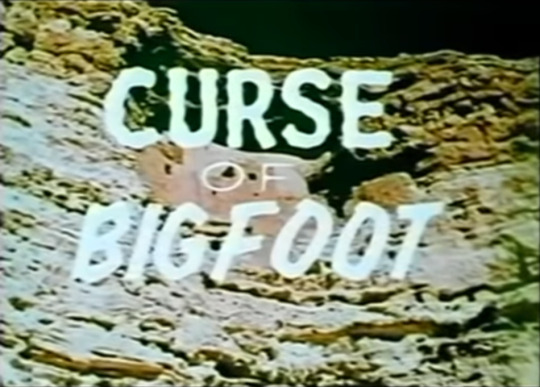
Curse of Bigfoot
This is a very bad mummy movie from the 60’s which was re-edited and re-released as an unbelievably bad bigfoot movie in the 70’s. It would belong on the Satellite of Love even if it didn’t have a small part for Jackie Neyman Jones. Remember her? Debbie from Manos: the Hands of Fate? Yeah, as far as I know she’s the only member of the cast ever to do any non-Manos-related film work for the entire rest of her life and it was this.
Once upon a time, somewhere in the American Southwest, Primitive Man was terrorized by Even More Primitive Man. In modern times, a Bigfootology professor is giving a guest lecture to a class of students. First he shows them a clip of a movie just as bad as the one we’re watching, then we get an inaccurate history of bigfoot, including the tale of two idiots in a pickup truck who get a big, hairy ass-whooping. Then, half an hour into the movie, we finally get to what’s supposed to be the main plot. A professor of archaeology takes some of his students into the wilderness to help excavate an ‘ancient Indian campsite’, but along with the expected potsherds and prayer sticks, they find a tomb containing a mummy from a lost prehistoric civilization. It comes to life and shambles off into the forest to kill people, because it’s a movie and mummies do that.
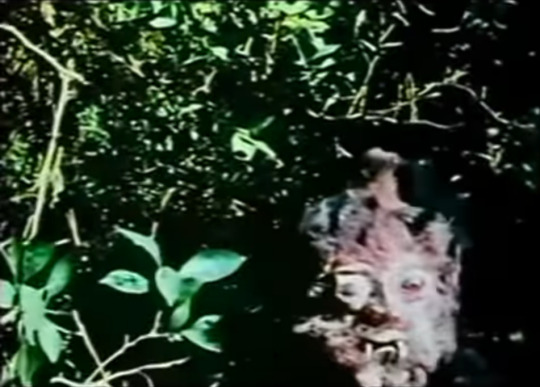
This movie does not waste time. It starts sucking right out of the gate. Almost everything that’s going to be wrong with it is introduced in the first ten minutes, as if the movie wants to prepare us for the ordeal ahead.
The opening sequence is an incredibly drawn-out scene of a woman getting up in the middle of the night to calm her barking dog, only to be killed by a zombie that wanders out of the woods. This scene is around six times longer than it needed to be. We almost have to watch every moment of the dog drinking a bowl of milk she pours for it. The woman’s voice was dubbed in post, and neither the voice nor the physical acting is any good. The sequence is supposed to take place in the middle of the night, but was clearly filmed at high noon, reaching Attack of the The Eye Creatures levels of not giving a shit in having the sun appear in several shots, standing in for the moon! The actual attack happens off screen, because the film-makers could not afford effects.
Then this part ends, and we realize that what we just saw was supposed to be a clip from a horror film that the professor was showing his students. This provides a fleeting moment of hope, as we think perhaps its overwhelming badness was intended as parody. No such luck. We then move into the two loggers getting stalked and killed by bigfoot. The monster costume is different, but this piece is identical in anti-quality to the zombie scene. The film-makers were just morons, and these mistakes continue throughout the entire ninety-minute run time.
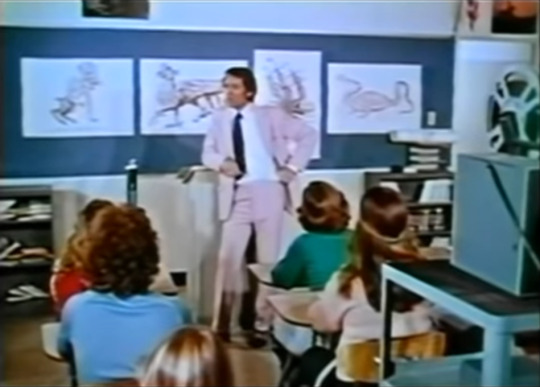
It’s actually astonishing that the movie is so consistent in its incompetence, because we are in fact watching two different films here. Curse of Bigfoot has a backstory similar to that of They Saved Hitler’s Brain, in that somebody in the fifties made a short movie and somebody else, years later, added useless filler to expand it into something they could show in a late-night TV slot. They Saved Hitler’s Brain feels very bifurcated, the new material being both narratively and stylistically different from Madmen of Mandoras. But if you didn’t know that Curse of Bigfoot was twenty minutes of extra film sewn onto a 1963 movie called Teenagers Battle the Thing, you might not immediately notice.
If you’ve been following this blog for a while you’ll probably remember that I thought Madmen of Mandoras was a significantly better movie than They Saved Hitler’s Brain (even if it still was definitely not a good movie) – the added footage was distracting and pointless. These two films, however, I would say are about equally awful. The footage added to Curse of Bigfoot is still pointless, but it looks exactly like what was originally shot for Teenagers Battle the Thing, the only noticeable difference being a slight change in the film stock! Both are depressingly earth-toned movies in which it takes for-fucking-ever for anything to happen, with night scenes shot in the blazing daylight, and lines dubbed in by bad voice actors over bad physical performances. Both feature shitty monster suits and every possible cost-cutting measure.
This leads me to wonder whether Curse of Bigfoot might be terrible on purpose. The people tasked with turning Teenagers Battle the Thing into a full-length movie got a couple of the actors back to play their older selves in the added footage. Making stuff match was clearly on their minds. Could they have actually thought things like, “we’d better use the wrong filter for this, or it won’t be as bad as the day-for-night in the original footage!” or “we need to pad this attack a bit, to match the pace!”? If so… I don’t know whether to be impressed, or just to crawl under the bed and cry.
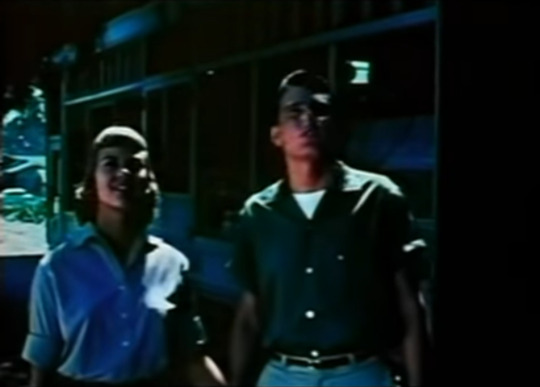
On the other hand, Curse of Bigfoot does at least try to do one thing better than Teenagers Battle the Thing – it wants to have something to say. It spells this thesis out for us in the opening narration and in the professor’s speech about horror movies: our society has forgotten about monsters.
We in the twenty-first century don’t spent much time thinking about monsters unless we happen to be film-makers, political commentators, or maybe paleontologists trying to figure out what the fuck this bugger is. It wasn’t so long ago, however, that they were very real to many people. Archaeological evidence suggests that people in New England believed in vampires as recently as the 1820s. Nowadays, monsters have been taking out of the ‘scary’ category and placed in the ‘fun’ one, and so when people report things like bigfoot or a sea serpent, we don’t take them very seriously.
Bigfoot, sea monsters, and vampires don’t really exist, obviously, but in losing our fear of monsters we may have lost a proper respect for nature. Every so often the newspapers in my city carry a story of some tourist who tried to get a better selfie with a grizzly bear and got mauled. We are so used to thinking that we have tamed nature, that there are no monsters left, that we don’t recognize danger when we’re confronted with it. This certainly seems to be a theme of the stories we’re presented with in Curse of Bigfoot: it never occurs to the woman in the opening that her barking dog may be trying to warn her of danger, or to the two loggers that the mysterious figure in the woods might mean them harm.
The party of archaeology students certainly don’t think they’re heading into any danger, despite the fact that they repeatedly do dangerous things. A group of them climb to the top of a cliff to see where a fallen stone came from, and never worry about falling. When they pry open the tomb entrance, the strange smoke that wafts out might be considered a warning sign, but they ignore it. They head right into this dark hole without any worries about rodents, rattlesnakes, or cave collapses. When one character warns the others that the mummy has just moved, they laugh it off. A couple go for a walk through the dark woods at night to get to a vending machine, without a second thought.
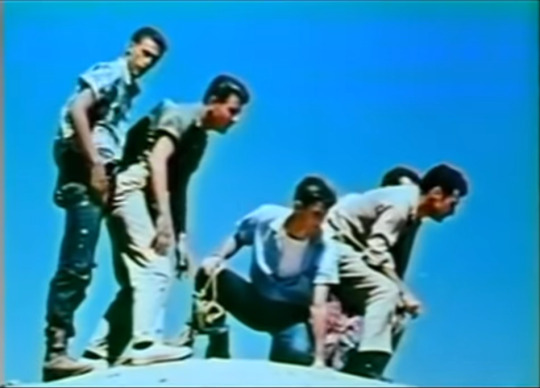
Lest you think I’m in any way praising this movie, I’m not – I just like my reviews to be at least a certain length, so sometimes I really dig for material. This was a dig on the level of saying The Incredible Melting Man is about how we treat the elderly. My high school English teacher might buy it, but I doubt anyone else would.
One thing I do wonder is why they chose to reframe this as a bigfoot movie. The footage from Teenagers Battle the Thing makes it very clear that this is a mummy movie, although they couldn’t afford any of the genre’s traditional accessories. Instead of a museum and a treasure, we get one cabin in the woods and… that’s all. When the characters talk about the situation, they always describe the monster as a mummy, and even when they theorize that it’s the product of a lost civilization, the idea that it may not be human never crosses their minds. It is not particularly tall. It is not remarkably hairy. It looks nothing like the bigfoot the two loggers saw, although it does somewhat resemble the zombie from the opening. Why the man telling the story decided this being must be bigfoot is an absolute mystery.
The only thing I can come up with as an explanation is that bigfoot movies were popular in the 1970s. Having seen a number of these, I can’t say I find them particularly inspiring.
Curse of Bigfoot is almost incomprehensibly boring, to the point where I’m not sure MST3K could have done much with it if they had featured it. In the opening sequence it takes forever for the woman to be attacked and then we don’t see it. In the logger sequence it takes forever for the guy to be attacked and then we don’t see it. And in the main plot it takes forever for anyone to be attacked and then we don’t see it! The only attack we see is when the mummy attacks the sheriff at the climax and that really, really wasn’t worth the wait.
Congratulations, Jackie Neyman Jones – you managed to be in a movie worse than Manos.
#mst3k#reviews#episodes that never were#curse of bigfoot#teenagers battle the thing#fuck this movie#all these movies have bigfoot in them#70s#we're running out of plots#cryptid cinema
42 notes
·
View notes
Note
how do you get into roleplaying on a ff server? like how do you do it and how do you know if your character is lore compliant? ;A; pls youre a big inspo to me
*Hugs Nonny* Getting into RP on a FF server can vary; I don’t actually RP much these days, outside of some friends I already have connections to--and that in itself can be difficult just due to Life! It can take time, and patience, and some fits and starts.
And this gets...really really long, so buckle up and go below the cut, please. :)
The cut got broken by an edit. Sigh.
In game there’s always the RP status tag, and just doing RP with folks in public spaces. There may be trolls now and then, but they can be ignored. I personally find Balmung’s Quicksand area too busy and anxiety inducing and not actually all that conducive to actual RP, even “meet at a tavern” walk-up type. But unless you already have a ready-made group of friends/FCmates willing to RP more than some random walk-ups with you, it may take some legwork to find folks you can and want to write with.
Social Media There are a couple of RP community blogs, like @mooglemeet and @ffxiv-crystal-rp and plenty of server-specific ones. There’s also some Discords for these communities. They host and advertise events and reblog people who are looking for RP contacts. Some of them have running gdoc calendars and in game linkshells and fellowships as well.
Shofie has a good post about Tumblr/social media RP blogging.
@shofie-ffxiv
It’s a fact now that social media outside game is a way to make contacts, or even a medium for RP itself. There are few centralized websites/forums for server RP communities anymore. Making connections over your social media, like Tumblr and Twitter, can help find RP. You can’t just throw your own character info out there or reblog prompts hoping others bite, though; you have to put in some work and show interest in others, too. This can be difficult and even scary. That’s OK.
RP is about collaboration and creating with other people, which means finding folks you can write with, and who see you as someone interesting but also interested in them and their OCs. If you want to keep it a solo endeavor focused on your own OCs, write fanfic (which I’ve actually made friends and gotten RP interests that way too through comment interactions, so hey).
If you reblog a prompt from someone, see others on your dash reblogging prompts, if people reblog that prompt post from you? Send them asks! Alternatively, don’t wait for prompts, just send asks, comments, or chats saying hello and things you notice or like about their blog/character/posts they make. Try to form connections with people you think are genuinely interesting and might be fun to talk with. Social media should be, well, social.
BUT respect boundaries, too. Don’t try sarcasm or jokes with people you don’t actually know, it tends to go over poorly. Unless someone’s specifically posting a naughty meme/prompt, keep stuff you others send clean and polite, especially if it’s unsolicited and you’re not already friends (doubly so if you don’t know how old they are IRL, there are laws you do not want to break). Respect if people aren’t open to random asks or chatting with new followers, or say “no” to RP, and know it’s not personal--it’s just what they have time, energy, and emotional/mental capacity for. Don’t give up on other people, though. This stuff can take time and effort to find those you click with.
Respect and communication with RP partners is pretty key.
Do curate your feeds and don’t be afraid to unfollow/mute/block folks, either. I’m selective in who I follow and remove as needed, too, for my own mental health. I miss so much of the discourse and drama and that’s fine by me. Also it costs nothing to not step in on a lot of the drama when it does pass in sight.
Profiles I have static RP profile pages for my girls here on Tumblr (and a lot of other static links and pages, but I’m weird about organizing like that). This way, if people want to write with me, send me prompts, if I sent them prompts, or they want to otherwise interact with my characters, the information is handily available. For some folks, this makes all the difference in who they choose to interact with: how easily can they find even basic info about your OC?
Some people make Carrds. Some folks have gdoc links, or use Dreamwidth, etc. Just keep the links in the blog’s sidebar menu, and/or in the blog desc so people can see ‘em on mobile. There are templates out there, or you can make your own. Feel free to snag mine if you’d like. A lot of times people also copy their profiles to rebloggable posts when looking for RP contacts. Profiles are a good way to let folks know just the at-a-glance basics about your character(s).
I picked a simple theme with a simple layout that makes it easy to add and show off links. I put them in the blog desc to make them easy to find on mobile, too.

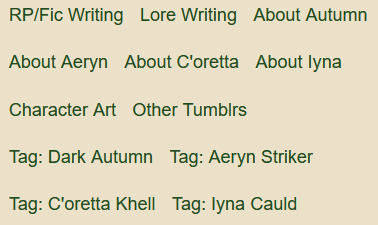
[Images: links from my blog sidebar menu showing how over organized I am]
RP, Stories, Lore Post some stories or RP logs (with permission of others involved) or even just random little blurbs and headcanons, as well as any screenshots, art, aesthetic posts for your OCs. Have something of interest to show for your character, too, so some of those folks your interacting with have something of their own to see and ask about!
If possible, try some light RP with friends and FC Mates who are amenable. Go to events, even if just to lurk at first. When you do get up the nerve to talk to people, don’t try to throw a character’s entire backstory at them, or try to steal the limelight--RP is collaboration, back and forth, and a lot like real conversation. Maybe come up with little light things to talk about if asked; a recent adventuring job, a silly shopping incident, etc. They can break the ice or just give you something to reply with for a few minutes.
Lore Compliance is Variable. Some people really want lore compliance, others are OK bending it here and there, while still others throw it out the window entirely. If you want to be super lore compliant...read. There’s a LOT of information, in game and out, for finding lore; from official publications and website material, to tools like Garland Tools site, to compilation blogs like @mirkemenagerie.
Note what’s important for your concept. Narrow it down. Characters aren’t going to know or be or do everything, so only worry about what’s necessary for the base idea. And be flexible; it’s SE’s sandbox, we just play in it, and they can change things any time. They usually do it in the guise of characters not knowing/having all the correct information, at least, but also some places just don’t exist in game yet so we don’t have info.
I’m unspecific about a lot of elements of Aeryn’s childhood, for instance, other than “traveling merchants near Thavnair.” I don’t have to be super specific. I can keep most details vague, and focus on her family and those relationships.
Dark, as my first character, has a fairly simple backstory that I’ve expanded on and adjusted over time as I learned and came up with new info. I also bet no one remembers I originally said Dark was from the North Shroud. I’ve changed things (now from East Shroud, due to the proximity to Gyr Abania and its Hellsguards) as I learned more about the world and my character. You don’t want to change things willy-nilly, but sometimes being flexible and smoothing down some rough edges and making small changes can be fine, especially as one gets more lore over time.
Iyna has a pretty detailed backstory, that came from a basic idea, and checking dates in the pre-Calamity timeline. I based her being taken and trained the way she was not only on what info we have about Garlemald’s imperial practices with conquered provinces, but borrowed a bit from real life and the re-education schools many Native Americans were forced into (though I haven’t gone into detail on that yet, either). I tied the turning point in Iyna’s life to a major event that wasn’t the Calamity, and have left plenty of space in between for me to fill in as time goes on and I learn more about her and the world.
The world isn’t static, and is bigger and more diverse than what can be shown in the game. There’s space in the margins for plenty of weird stuff and contradictions or unusual cases. So read up on what you can, ask questions, and then find where in those spaces your OC fits. Then, find people who enjoy similar tastes in lore compliance (or non-compliance), and who enjoy playing with you and your OCs, and not worrying about the rest. Can’t please everyone, nor get along with everyone, so don’t try; just find what works for you, and who works with you, and don’t police anyone else’s pretendy fun times, either.
There’s no magic answer on the “right” amount of lore compliance, or how to quickly and easily find RP partners or break into the broader RP community.
I hope this helps at least a little bit! Good luck in finding your niche for RP, and maybe I’ll see you sometime at an event :)
#roleplay#blogging#writing#social media#long post#nonny got me thinking#some links#hope this helps?#Anonymous
34 notes
·
View notes
Text
Japanese Literature
Henlo there demons, it’s ya boi, Nyah Lajom.
East Asia is where you'll find China, Hong Kong, Japan, Macau, Mongolia, North and South Korea, and Taiwan.
In this blog, I will be talking about the prevalent themes of literature in Japan throughout the history.
Long ago, the Japanese citizens farmed together in harmony and then everything changed when the Portuguese empire attacked. They brought a brand new religion from the far far west, Catholicism, and new innovations like guns and gun powder.
In antiquated writing, just like in the Philippines, information is passed down orally, this implies that over the long haul, some of it is lost or changed. However, at that point, writing was introduced to Japan by the Chinese via Koreans.

ANCIENT LITERATURE (8th Century)
(���ʟᴇᴀꜱᴇ ɴᴏᴛᴇ ᴛʜᴀᴛ ʜᴇ ᴛɪᴍᴇʟɪɴᴇ ɪ ᴜꜱᴇᴅ ɪɴ ᴛʜɪꜱ ᴘᴇʀɪᴏᴅ ɪꜱ ᴜɴᴏꜰꜰɪᴄɪᴀʟ)
The most established enduring works are the Kojiki and Nihon Shoki, the two books were passed down through oral literature.
Kojiki (Record of Ancient Matters) is a book about the myths and legends of Japan.
Nihon Shoki (Chronicles of Japan) is the chronological record of history.
Both works were from early 8th Century and are government projects.

CLASSICAL LITERATURE (794-1185)
During the Heian Period, the nobles and rich were fascinated by the Chinese culture, respectable men utilized the Chinese language similarly that Medieval European aristocrats and ministers utilized Latin. In Heian Japan, women were not permitted to speak Chinese. (Misogyny was rampant at the time)
Early 11th Century, Murasaki Shikibu wrote the world’s first novel, The Tale of Kenji. The novel enables us to see how aristocrats live because it’s about a man named Kenji and his gag with women and nobles. It is said that The moral of the story is that affection isn't about the craving of having intercourse with some ladies or about the battle to overcome every single pretty woman. Be that as it may, love should be kept with a lady we love for eternity.
Genji shows how extraordinary the thing that matters was between the sexual orientations by having characters experience passionate feelings for one another dependent on their penmanship.

Mid 10th Century, Tosa Hiromichi wrote Taketori Monogatari. The story details the life of Kaguya-hime, a princess from the Moon who is discovered as a baby inside the stalk of a glowing bamboo plant.
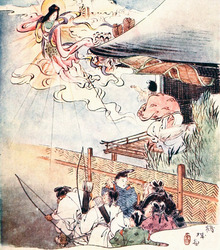
MEDIEVAL LITERATURE (1185-1600)
The Medieval Literature was basically Japan having civil wars and books were all about it.
An example of this is Taiheiki (Chronicle of Great Peace), composed in the late 14th century, is a Japanese historical epic and covers the period from 1319 to 1367. It deals mainly with Nanboku-chō, the time of conflict between the Kyoto Ashikaga Takauji Northern Court and the Yoshino Southern Court of Emperor Go-Daigo.
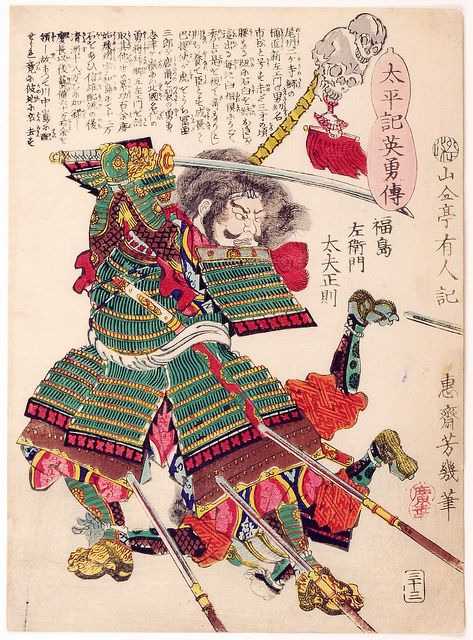
The dominant theme in this era is Zen Buddhism. It’s about life, spirituality, and existence. The writers in this time tackled more on existential crises and death. It’s like the Greek philosophers but make it ✨ j a p a n e s e ✨
Let me give you another example of writers and their work. Yoshida Kenko's Tsurezuregusa (Essays in Idleness) and Kamo no Chomei's Hojoki (An Account of My Hut) just like I said earlier, the question of eternal redemption is posed by both works.
(Tsurezuregusa)
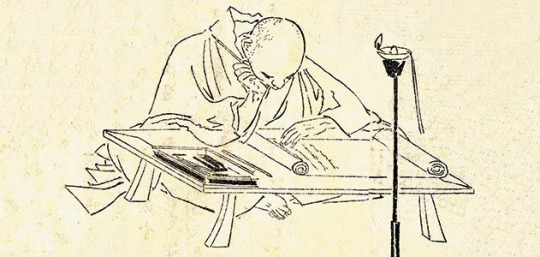
(Hojoki)

EDO PERIOD (1600-1868)
The Edo period was really the rise of popular culture in Japan. Increased leisure time gave the rising merchant class a chance to explore things like bathhouses, the theater, and reading. A lot happened in this era so I’m gonna summarize it.
The position of literature as a means of social intercourse expanded.
Haiku is perfected and seen as the embodiment of elegant simplicity.
In the new capital of Edo (modern Tokyo), due in large part to the growth of the working and middle classes, types of common drama emerged that would later evolve into Kabuki.
Literacy rate rose.
The introduction of Chinese vernacular fiction which has shown the greatest external effect on the production of Japanese fiction in the Early Modern period.
In the development of the Yomihon, which were historical romances almost entirely in prose, Tsuga Teisho, Takebe Ayatari, and Okajima Kanzan were instrumental.
Santo Kyoden wrote Yomihon, often set in gay quarters, before such works were banned by the Kansei edicts, and he turned to comic Kibyoshi. Genres included horror, stories of crime, stories of morality, satire, and pornography, frequently accompanied by colorful prints of woodcut.
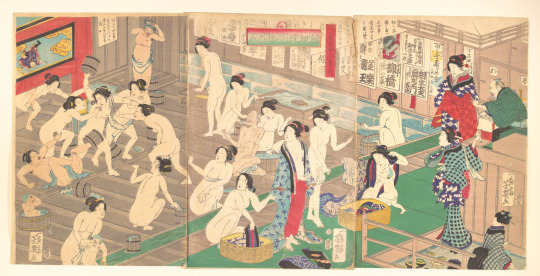
MEIJI PERIOD (1868-1945)
The Meiji Period parkoured over themes so I’m just gonna put the timelines and its dominant themes.
1868-1880′s Realism is the dominating literature theme. In a simple style between literary and colloquial, Ichiyo Higuchi, a rare woman writer in this period, wrote short stories about powerless women of this generation.
1889-1905 Romanticism was brought in by Mori Ogai, and hen Toson Shimazaki carried it to its height.
1906-1910 Naturalism, Shimazaki shifted to Naturalism, this describes the authors themselves and depicts their own mental states.
1920-1930 Socio-political created by Takiji Kobayashi, Denji Kuroshima, Yuriko Miyamoto, and Ineko Sata portrays the harsh lives of laborers, peasants, women, and other downtrodden members of society and their struggles for change.
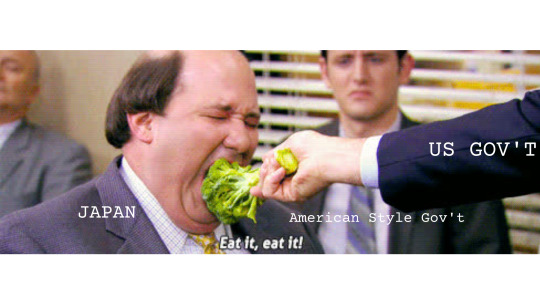
Meiji Period in a nutshell.
POST-WAR PERIOD (1945-Present)
After the WWII, Japan was defeated and many expressed their disaffection, loss of purpose. The predominant theme in is Socio-political commentary then in the early 1980′s popular fiction became the mainstream theme until now.

Nyah Lajom
4 notes
·
View notes
Text
Netflix’s Witcher: What Makes a Good Adaptation? – A companion piece
If you’ve somehow found this without seeing the video first, here’s a link:
In this video I analyze the screen adaptations of Lord of the Rings, A Song of Ice and Fire, and the Witcher series. I use the comparisons of the three to discuss what makes adaptations in general work and to explain why I feel the Witcher is heading down the road to mediocrity.
However, this is a hugely complicated subject, and the works themselves are also complex, especially Martin’s work. I make plenty of claims in the video that a reasonable person could disagree with without any explanation for why I think they are true. Unfortunately, if I were to go down every rabbit hole that I touch on the video would be hours long, so I have to gloss over some potentially confusing or controversial statements.
Enter this post. Here I will be attempting to pre-empt any questions that I think people may have, and go through my thought process on certain claims. I don’t recommend that you read the whole thing. Each explanation will be followed by a timestamp and relevant quote from the video that I am expanding upon so that you can quickly search the page and find what you are looking for.
I’m sure there will be things I don’t think to cover, or things that are poorly reasoned both here and in the video, so feel free to ask additional questions. Just please check to make sure you aren’t asking something that I already covered here.
I will also be attempting to give as much credit as possible to all the wonderful writers and creators who have influenced my thinking with regards to these works. I’ll be linking as much as possible to my sources, as well as to additional content that expands on ideas I mention. Also I’ve included some personal tidbits and commentary, just for fun.
Under a cut for length.
INTRODUCTION:
Huge props to the people who put together the behind-the-scenes footage of LOTR. I’ve watched all the bonus footage numerous times in my life. If you have any interest in the nitty-gritty of how movies get made, I can’t recommend it enough. It really shows all the work and complexity that goes into making movies. That they even get made at all is honestly incredible, especially massive undertakings like LOTR.
[3:30] And if you've ever wondered what the hell happened to The Hobbit, to me it seemed like they were indulging all of these worst impulses instead of catching themselves and editing them out like they did in LOTR.
As soon as I saw that they were making three Hobbit movies my hopes plummeted. It just reeked of executive meddling, and of trying to make the story into something it just isn’t. Lo and behold, that’s what we got: sticking in loads of unnecessary and thematically incoherent material to stretch out the runtime and make it more “epic.” I couldn’t bring myself to watch past the first one, but Lindsay Ellis has an excellent video series exploring in detail what went wrong with the trilogy.
PART ONE: LORD OF THE RINGS
[8:40] If you followed the events and the chronology of the book they would just hang out with Faramir for a little bit and then the movie would end
Technically it’s more complicated than this because that’s already following the revised movie timeline. In reality, Frodo would have just left the Black Gate. They *are* moving the events around to some extent, usually by a few of days here and there, but they can’t move stuff together that takes place weeks apart or the whole timeline would crumble.
[9:55] You can call it the theme, the soul, the spirit, the point, or whatever else you want, but the great works of fiction have something at their core that pulls everything together and elevates it into art. It’s a difficult thing to describe, but I think this scene perfectly tapped into the soul of Tolkien’s work.
Huge shout out to Bob Case and his video “Blame of Thrones” for first introducing me to this concept and the language of the “spirit” of a work to describe this phenomenon. In many ways the first two parts of this video are merely building on the LOTR-GOT comparison that he makes in that video, digging a little deeper and looking at more specific and concrete (and spoileriffic) examples of what he’s talking about so that we can apply these ideas to the Witcher…and beyond. Like all his work, it’s excellent. His YouTube is pretty much inactive these days, but he also occasionally writes content for Shamus Young’s blog if you want more of his work.
PART TWO: GAME OF THRONES
Alright, here it is: the section that really caused me to want to make this companion piece. Earlier I mentioned that I have sympathy for the GoT showrunners, and I really do. Martin’s work is incredibly complex, and so this section dominates the blogpost because there is so much to explain and no way that I could explain it all in the video without incredible bloat.
First I should mention that I, and all the writers I am going to credit here, share a very specific interpretation of Martin’s work. This isn’t the only interpretation. I doubt it’s the interpretation of the majority of readers. Obviously, I fully believe it is the correct interpretation, but the showrunners clearly had a wildly different one.
People who have this interpretation express it in different ways. Joannalannister collects hers in her tag #the-meaning-of-asoiaf. PoorQuentyn expresses it here, and in his analysis of Davos, Quentyn, and Tyrion. Other writers express it in their own ways.
With my lit degree hanging over my head, I can’t help but see it as a problem of competing artistic movements. To me, HBO’s Game of Thrones is part of the art movement of the past few decades, namely postmodernism. Art movements are complex, but basically postmodernism is the cynical reaction to the sincerity of modernism which came before it. Cynicism is, I think, the defining trait of Game of Thrones.
But it is NOT the defining trait of the books. In my view, Martin’s ASOIAF is part of the art movement that we are moving towards, which is starting to become known as metamodernism. Metamodernism is a reaction to the nihilistic pessimism and cynicism of postmodernism, and replaces it not with the unbridled sincerity of modernism, but rather oscillation between the two modes. It can be both ironic and sincere, deconstructionist and constructionist, apathetic and affectual. Once you have peeled back all the layers however, it is ultimately hopeful and optimistic. It embraces a sense of radical optimism. In metamodernist works optimism is often radical because the world the characters live in can be so dark. But that darkness serves only to highlight those characters that can hold fast to virtue amidst such darkness.
So, be warned. If you believe that Martin’s work is all about controlling the Iron Throne, and believe that cynicism is for the wise and honor is for fools, we just aren’t going to see eye to eye.
[12:45] Ned is a competent northern politician who has some trouble adapting to southern culture. Through a combination of bad luck, some understandable mistakes, and a misconception about his position, he fails in his goals.
The show didn’t invent the idea of Stupid Honorable Ned. Plenty of people believed this, even before the show. Obviously I believe they are wrong. If you would like to read more about it I would suggest Steven Attewell’s analysis of Ned’s chapters that he does on his blog, particularly Eddard XI and Eddard XIII. Steven does a much better job of analyzing Ned as a political actor than I ever could.
[13:00] Most of these changes are subtle…the best example is the council debate about whether or not to assassinate Daenerys.
Many of the ideas in this section are pulled from two essays by turtle-paced: Poor Doomed Ned and The Argument to Assassinate Daenerys. Turtle goes deep into the details of the differences between the Ned Stark of the books and the show, and I skimmed some of their comparisons for my argument. Steven Attewell’s analysis of this chapter is also worth reading.
[14:09] It’s a good argument, and I think in the books we are expected to mostly agree with Ned, both morally and politically.
When I say “expected” I mean from the authors point of view, which of course relies on me being correct about my interpretation of Martin’s work. Obviously I think I’m right, but if you don’t agree with my interpretation you may not agree with this statement.
[14:16] Notice also that the supporters of the assassination: Littlefinger, Varys, Renly, and Pycelle are all villains (all except Pycelle are trying to destabilize the kingdom), and the people who oppose it, Ned and Barristan, are heroes.
Each of them represents a different sort of evil. Littlefinger is a scheming sociopathic villain. Varys is a well-intentioned extremist whose willingness to commit utterly heinous acts in the pursuit of his goals makes him a villain. This is because, as Huxley puts it, “The end cannot justify the means, for the simple and obvious reason that the means employed determine the nature of the ends produced.” Renly is narcissistic ambitious evil, willing to throw a realm into war to satisfy his own ego, and is totally uncaring about the lives of other people. It isn’t precisely correct to say that Pycelle is a villain because he represents the banality of evil. He thinks he’s just doing his job, but he’s morally bankrupt and politically corrupt.
[16:40] It would take too long to list all the ways that Tywin is awful, and everyone knows it.
To clarify, I mean that everyone in-universe knows it. For some god-forsaken reason, some readers seem to think that Tywin was just being effective after he unleashed the Mountain on the Riverlands and violated every military and political norm in Westeros.
If you are going to say that he is “Machiavellian” I would encourage you to actually read The Prince, where Machiavelli says “Nevertheless a prince ought to inspire fear in such a way that, if he does not win love, he avoids hatred” and goes into the reasons why.
[17:17] Tywin on the other hand accomplished a lot of short-term gains by being as treacherous and dishonorable as possible. But this has a cost: by proving themselves fair-weather allies they surround themselves with the same. Nobody trusts them, and so their allies scheme and betray them.
Oberyn and Doran are both scheming in their own way to revenge themselves on the Lannisters for the deaths of Elia and her children. The Tyrells poison Joffrey and scheme to spirit Sansa away to Highgarden.
[17:36] Ned failed due to a couple of minor mistakes, some bad luck, and treachery.
I mention a few times that Ned, and more broadly the Starks, get “unlucky.” Again, Steven Attewell does an excellent job of documenting this with his keen eye for how GRRM cheats political realities, but I’ll note a few of the many ways George has to bend over backward to screw the Starks.
In AGoT Catelyn leaves King’s Landing roughly around the same time that Tyrion leaves the wall, and both are on horseback. In order for them to meet at the Inn at the Crossroads Tyrion has to travel roughly 2,000 miles in the same time that Catelyn travels 400 miles. This is basically impossible, but necessary for the plot so that Catelyn can lose Tyrion at the Eyrie. If she had caught him somewhere further north she could have simply chucked him into her own dungeons and managed his trial herself.
Cersei has been trying to kill Robert for goodness knows how long with just as unreliable methods as “get him drunk on a hunt.” In order for Ned to get screwed she has to succeed in killing Robert at precisely that moment. If it had failed like every one of her other attempts she is most likely dead, because Ned would tell Robert the truth about her children as soon as he got back.
In order for Theon to take Winterfell, veteran military man and castellan Ser Rodrik Cassell has to stupidly empty the Winterfell garrison while he knows that Ironborn raiders are running loose in the North, not even leaving behind a mere twenty-five to fifty men that would have completely thrashed Theon’s assault. If Theon can’t take Winterfell, the Red Wedding doesn’t happen (as Martin has told us that the real inciting incident of the Red Wedding was the fall of Winterfell).
[17:41] However, killing him was a terrible idea, and backfired on the Lannisters instantly.
Continuing this theme, the Lannisters were in an absolutely horrible position at the beginning of the War of the Five Kings. They pretty much just have their bannerman in the Westerlands. Stannis seems to have the support of most of the Crownlands, and he and Renly are splitting the lords of the Reach and the Stormlands (with Renly having the larger chunk). The Starks have all the support of the North and the Riverlands combined. The Lannisters are surrounded by enemies who outnumber them on all sides. Killing Ned immediately jumpstarts a war that will almost certainly crush the Lannisters. That it didn’t took some very thin plotting and improbable developments at times, but overall George made it work. For more analysis of this, again check out Steven Attewell Blog: Race for the Iron Throne.
[17:48] Tywin was killed by both a guest whom he considered his ally, and his son.
I firmly believe Oberyn poisoned Tywin. Here’s a good rundown of the evidence. Beyond simple means, motive, and opportunity it also provides neat answers to lingering odd questions like why Tywin rotted so oddly and aggressively, why Tyrion knew he would find him in the privy, why Oberyn was willing to chuck his life away for a confession before seeming to have secured revenge against Tywin.
It’s also thematically juicy. I love the idea that Tywin, who so egregiously violated Westerosi norms culminating in the total breach of the social contract at the Red Wedding, was a victim of contrapasso. He can’t be protected by social norms, so he gets poisoned by his guest and ally. Did Tyrion know he was dying? Had he put it all together? Was that bolt really an act of mercy? Perhaps it was one final service to the Lannisters, to keep the dream of their alliance with the Martells alive. Who knows, but boy is it interesting to consider.
[18:13] his alliances fall to pieces, and his children are abandoned by even their own family.
I’m referring here to the infighting between the Tyrells and Lannisters (and Martells, though they never had any intent of staying true to the alliance) after Tywin’s death (though there was some before as well, just intensified after Cersei takes over from Tywin). Kevan forces Cersei to take the walk of shame, and Jaime and the rest of the Lannisters abandon her to that fate.
[19:41] Just like Lord of the Rings, and the Witcher, ASOIAF is clearly dedicated to anti-violence. Not pacifism: all three works have heroes dealing out retributive violence in order to try and restore justice.
I understand it might be odd to suggest that three works which feature so much violence can be dedicated to anti-violence, but depicting something is not the same as endorsing it. I would argue in the case of Martin’s work in particular that his depiction of violence, so un-romantically brutal and direct, is intentionally revolting, and therefore is designed to be anti-violence. Martin purposefully makes you want revenge on certain characters, gives it to you, and then forces you to stare at the inhumanity of this thing you thought you wanted. Yeah I wanted Theon to pay, but not like that. Yeah, I wanted Cersei to pay, but not like that. Yeah, I want the Freys to pay, but I don’t think I’m going to like what Stoneheart is going to do to them.
There is a certain amount of this in the Witcher as well. I can specifically think of one scene in The Blood of Elves, but I promised no Witcher spoilers.
The violence in LOTR is much more romanticized, but as Faramir says: “I do not love the bright sword for its sharpness, nor the arrow for its swiftness, nor the warrior for his glory. I love only that which they defend.” The hero is still Frodo, who doesn’t fight anyone or anything in the whole story. Frodo is a pacifist, but his pacifism is enabled by others who are willing to fight.
[20:07] In a Dance with Dragons Daenerys allows the old slave-holding class to maintain too much power and so they immediately attempt to continue the old violence of slavery. Daenerys did not commit enough violence against the slave-owners, so they were allowed to continue existing, and as long as they existed they were always going to abuse and oppress the ex-slaves.
A couple years after the release of ADWD, an obnoxiously wrong and poisonous idea began to creep into the ASOIAF fandom: Daenerys’ violence against the slaveowners in Slaver’s Bay is dangerous and immoral, and peace is the better option. This idea was most persuasively argued in the Meereenese Blot’s series of essays.
I’ll quote some of the conclusion here:
“They are supposed to feel this generic distrust for everyone, and to fail to grasp that their peaces were actually quite successful. Dany is supposed to conclude — wrongly — that her behavior through most of the book was silly and foolish. And if you came away with those impressions too, it’s perfectly understandable…The whole plotline is designed to maneuver Dany into a mental place where she’ll decide to sideline her concerns for innocent life, and take what she wants with fire and blood.”
This idea, much like the idea that Daenerys is some sort of unhinged fascist just waiting for the right trigger, makes me unbelievably angry. This idea that I am supposed to value the life of the slaveowner and the slave equally, and that maintaining a “peaceful” slave-owning society is an acceptable alternative to violent revolution is so fundamentally revolting to me, that it turns my stomach even to write that sentence.
Some fans went even as far as to suggest that Daenerys’ occupation of Meereen was a parallel to the US occupation of Iraq, and that she was engaged in erasing an authentic slave-owning culture that she despised. If you read the above series of essays, you can see that they are, at the least, enabling that kind of thinking.
To be clear, I do not consider any slave society to be worth a damn thing. Anything that continues it is evil and all that attempts to destroy it is good. That being said, once again Steven Attewell does a better job than I ever could of rebutting the ideas of the Meereneese Blot, and explaining how the correct parallel of Daenerys’ actions in Meereen is the American mistake of abandoning radical reconstruction. He describes her actions in Meereen as abandoning a revolution half complete. I highly recommend reading it, especially if you are American.
Martin is not a pacifist. He has said he would have fought in WWII. He demonstrated against Vietnam. As far as I know, the first time George ever used the words “Fire and Blood” was in a book released in 1982 called Fevre Dream:
“I never held much with slavery […]. You can’t just go… usin’ another kind of people, like they wasn’t people at all. Know what I mean? Got to end, sooner or later. Better if it ends peaceful, but it’s got to end even if it has to be with fire and blood, you see? Maybe that’s what them abolitionists been sayin’ all along. You try to be reasonable, that’s only right, but if it don’t work, you got to be ready. Some things is just wrong. They got to be ended.”
Daenerys is a slave-freeing, slave-owner-killing Hero with a capital H. She has made mistakes. I weep for the lives of the slaves that she has thrown away by abandoning her revolution, by failing to give the people of Astapor the strength to defend themselves, by maintaining a false peace that allows the Meereneese KKK to kill ex-slaves in the night. I shed no tears for the slaveowners that she has killed. When you treat other human beings as property you forfeit your right to Prosperity, Freedom, and Life. Preferably in that order—I would prefer that a slave society could peacefully transition, that those who attempted to continue it could be locked up, and that bloodshed could be avoided. But sometimes violence is necessary.
Daenerys will make more mistakes, I am sure. I believe that she will swing too far in the other direction, temporarily. But that’s a topic for another time.
[20:57] She comforts the hound even as he threatens her and helps him on his path from violence to peace.
Sandor did not die, despite what the Elder Brother told Brienne. He uses his words very carefully, to suggest that the Hound is dead, but that Sandor Clegane the man is simply “at rest.” He has become a brother of the isle.
“On the upper slopes they saw three boys driving sheep, and higher still they passed a lichyard where a brother bigger than Brienne was struggling to dig a grave. From the way he moved, it was plain to see that he was lame.” - Brienne VI, AFFC
[21:40] If they don’t understand why Tywin is a villain then of course they won’t understand why the Others are the main villains of the series, and will probably replace them with some blonde queen. And if you don’t understand that the cold of the human heart is the real enemy than of course you’ll think you can stop winter by just stabbing it. Like Tywin would.
In the books the Others are the villains. They are what the whole story is building towards, much like in LOTR the story builds towards Frodo casting the ring into the Fire. Martin has said that he thinks that the finishing chapters of LOTR, like the Scouring of the Shire, were important, so we may see something like that, but the clear emphasis will be on the existential evil, and cleaning up Cersei or Aegon “Targaryen’s” mess will be a clear step down in importance. It’s something that the heroes have grown beyond, but still need to handle, just like Saruman in the Shire.
[22:04] There’s nothing wrong with liking Game of Thrones, or disliking Lord of the Rings, or anything else.
I really do mean this. I am going to be critical of things you like, and am going to praise things you love. People are different, that’s to be expected. I am not here to pretend that people should only like the things I like. I’m interested in what makes these stories work. I said much the same thing in my last video about some of the new Star Wars properties. People tend to get really attached to the media they like (I’m no exception) and that can color our perception of criticism. Do try to keep in mind that if you like something I criticize it isn’t an attack on you. You have a sacred and personal relationship to the things you enjoy that no one can take from you. I like all kinds of stuff that other people might consider bad, and that’s okay. Actually it’s great, because it gives us something to talk about.
I may genuinely hate Game of Thrones because it butchers something I came to love, but that doesn’t mean I have anything against the people who do like it for their own reasons. We’re all just out here enjoying what we like.
PART THREE: THE WITCHER
There is less in this section for two reasons. First, I promised not to spoil anything past the material covered in the show and I’ll stick to that here. Second—full disclosure here—I haven’t read all of the books because after Blood of Elves I got pretty bored and from what I had heard they did not improve in quality, and if anything got worse. Having already felt that going from the anthologies to Blood I was happy to end my reading there.
If something I say is contradicted by a later book that I didn’t read feel free to let me know.
[23:31] First I should mention that Sapkowski’s works are not on the same level as Tolkien’s and Martin’s, who are the best and second-best fantasy authors of all time. I have enjoyed the Witcher books that I have read, but they are not anywhere near as complex or beautifully written.
This is just my opinion, see above paragraph. I really do think that it’s a pretty common opinion though. I’ve read it before, and you often see people recommend the first two Witcher anthologies in a “if you like it maybe see if you like the rest of them?” sort of way. Book sales numbers also support this, though by all accounts they are exploding in the wake of the show.
But, one potential issue is that I’m reading a translation so I have no idea how good Sapkowski’s prose actually is. You get a lot of sentences in the US edition like: “it must be both bothersome and irritating.” Translation is art, not science, and passages like these make me worry that the translator is just translating each phrase without worrying about all the subtlety that makes language beautiful. These are minor examples of course, but they worry me about what else might be changed. So take my criticism of his writing with a giant, translated, grain of salt, in that I don’t read Polish.
[23:58] Despite this, Geralt the Witcher has been worming his way into popular culture for years, interestingly on the back of a series of video games
Google trends clearly show that the video games are what primarily generated interest in the character before the show. There were no English editions until around the time the games started coming out, and the US editions all feature concept art from the games on the covers. The release of the subsequently translated books after the games received very little attention in comparison to the games.
[24:15] In my opinion, that decline of focus on Geralt was the greatest weakness in the books, and the focus on Geralt is the greatest strength of the games. Because Geralt is at the core of what made Sapkowski’s story and world engaging in the first place. He is a fascinating character in a way that Ciri, who is a fairly standard fantasy “chosen child,” could never be.
This is just my opinion, and I explain why I think Geralt is so great in the subsequent paragraphs. Reasonable people can disagree on this, but I’ve come across more than a couple fantasy characters who could be generically described as “royal orphans with special powers.” It’s not exactly novel. Geralt is pretty novel, at least in terms of what I have read.
[24:49] He suffers many of the same psychological problems that characters like Tyrion and Brienne suffer from in Martin’s work
The technical name for these kinds of issues is “internalized bigotry.” This happens when you get treated consistently horribly by the society you live in due to some fundamental fact about yourself that you didn’t choose, and eventually you begin to believe and “internalize” their opinion of you. For example, people expect Tyrion to be unlovable, conniving, lecherous, and debauched. Eventually he simply leans into these characteristics, because in a way it’s almost easier to be what people expect you to be.
[25:48] To top it off, he hides all this inside a cynical and nihilistic exterior, he pretends he doesn’t care when in fact, he cares more than anyone.
The shot that accompanies this, of Geralt looking intently at what’s happening in the room while others tend to be watching with a sort of mild curiosity like you might at an unexpected circus performance, did an awesome job of conveying this idea.
[26:36] This was kind of a cool idea, but predictably their scenes ended up being generally less interesting and engaging then Geralt’s. Yennefer’s were sometimes fantastic but Ciri’s rarely were.
This was the opinion of fans that I most commonly observed. I don’t have any empirical evidence of this. If you have any that either supports or contradicts this please let me know, I would be fascinated to see it. I could see someone really loving Yennefer’s scenes, and I personally enjoyed a lot of them, but I don’t understand how someone could walk away from the first season with Ciri as their favorite character of the three. I’ll come back to this in a later section.
[27:40] In many ways the first two books, and the games, have more in common with Sherlock Holmes than they do most other fantasy stories.
Really a more accurate comparison would be Philip Marlowe since Geralt is definitely more of an American Pulp detective than a British one. I do love the similarity between Geralt’s Witcher Senses in The Witcher 3 and Sherlock’s detective vision in Crimes and Punishment. I can’t make the same comparison to a Philip Marlowe game, because no one’s made one yet.
Actually that’s not strictly true. There was one game that came out in 1996.
[28:12] But Netflix’s Witcher has barely a whiff of detective fiction anywhere. I think this has caused a lot of fans to feel alienated by the show, even if they can’t explain exactly why.
It’s not reasonable to expect people to know why they like or don’t like something. It’s a feeling, and unless they have experience with writing, narratology, literature, film studies, or just read a lot of tvtropes.org, they are not likely to be able to put their finger on what it is. This causes people to disproportionally blame the things that are most obviously wrong. The premiere example of this is Jar Jar Binks in The Phantom Menace. Jar Jar was obviously bad, but he doesn’t even come close to the top ten biggest problems with the movie. It was much worse that there was no main character or understandable plot and drama. Check out Red Letter Media’s legendary review for more on that.
I think a similar thing happened with Ciri, in that her story was sort of obviously underwhelming and so received a lot of flak, but there are deeper problems with the show.
[32:04] The third change is more subtle, but I’m worried that this Geralt genuinely believes in neutrality.
Just like Ned, the showrunners would not be the first to espouse this view. This quote in particular about “evil is evil” is obnoxiously peddled about as a justification for fence-sitting despite the fact that Geralt’s actual behavior doesn’t support it at all.
I don’t know for sure if the showrunners genuinely think Geralt tries to be neutral. There’s some evidence for yes in the first episode, the Borch episode, the Striga episode, and a couple of others. There’s strong evidence for no in the Duny/Pavetta episode. We’ll just have to see.
To be clear, when I mean “neutral” I mean in the face of immediate violence or injustice. Geralt often doesn’t care who is king, as he explains to Ostrit. But he won’t let a Striga continue to kill people just for coin.
[37:20] When the writers took away Ned’s best arguments for his actions, when they took his story of existential triumph, of not compromising his morals, and turned it into a simple tragedy, they showed they clearly did not understand his heroism.
See PoorQuentyn’s explanation of existential heroism, and how it applies to ASOIAF.
[37:58] In the books, Ciri and Yennefer are included in the story through their connection to Geralt, because he is our hero and the foundation of our connection to the world. In the show they are included before ever having met Geralt, and they take up time that could have been spent focusing on those devilish detective details that make Geralt’s stories and character work.
Originally this video had a lot of discussion about how well these two other characters worked, but it ended up being kind of useless because it comes down to personal opinion, and the writers failure to properly use Geralt massively overshadows whether or not someone liked or didn’t like either of the other two leads. Again, I get why someone could like Yennefer’s scenes. I get why someone could maybe even like her scenes more than Geralt’s. Anya Chalotra did great. I thought the writing was a little weak at times, but on balance pretty decent. Geralt gets the benefit of all his stories being straight adaptations, and she didn’t, so it was a pretty decent job.
On the other hand, I thought Ciri’s storyline was a giant waste of space. When I think of all the best moments in the show, Ciri doesn’t show up in any of them. She spends the entire season running away from and interacting with fairly minor and forgettable characters that did not need to be introduced in this season. Calanthe, Eist, and Mousesack were great characters and the actors gave great performances, but that did not make up for the fact that her storyline went nowhere and did nothing to justify its inclusion. If someone loved Ciri’s storyline I would genuinely be interested to know why.
[39:10] I do have some sympathy for the writers of the Witcher.
Many times in this video I mention sympathy for various writers. Moviemaking is a massively complex undertaking. If you know anything about the difficulty of getting these things together you’ll know that it’s an absolute miracle any movie gets made and takes herculean effort from everyone involved. Television series are arguably even worse because they are longer, more complex, and often have a lower budget despite that. The people involved are honestly doing their best, and I recognize that, even if I criticize the product.
[39:47] They are in this unfortunate position where they can’t really pull the majority of their writing straight from the books because the material isn’t really strong enough by itself.
The books are very dialogue heavy. As I allude to, the one scene that was very close to the book is that scene with Filavandrel and it’s just obnoxious because the two characters just dialogue at each other. It goes on even longer in the book. How well that works in a book is up for debate but it wasn’t going to work on the screen, and it didn’t.
These problems are not insurmountable though. You can put other footage over these monologues. You could have included some footage of Elves fighting in their war. You could have footage of the “cursed” daughters of Lilit being locked in towers or autopsied while Stregobor explains it. I get this is more budget, but that budget went other places.
On the other hand some great scenes that I think would have translated excellently shot-for-shot from the book with little additional budget, like Renfri and Geralt in the Alderman’s attic, are entirely cut. Ah well.
[40:25] Well, I have my theories, but it in the end it doesn’t really matter.
I have a sneaking suspicion that somebody thought it needed to be more “epic” than the first two books are, so we got all this princess and political stuff in early. If there’s any merit to the idea that this series “copied” GoT, it’s somewhere in here, just like how the Hobbit got poisoned with all of the “epicness” of LOTR.
[44:54] Lastly, I’m gonna do my best to put out more regular content going forward. I’m aiming for at least one video a month.
I place no limitation on topics. It’ll probably be mostly media analysis, but if I’m honest I’m just going to write about whatever interests me. That’s the best way to keep myself interested.
That being said, if you have something you think I should analyze let me know. If I’m interested, I might do it.
#witcher#netflix witcher#lotr#asoiaf#game of thrones#anti-got#lord of the rings#adaptation#video companions
6 notes
·
View notes
Text
Week 1 - Start of Project
My chosen 10 words are:
Surface - The surface is the outside of anything. The earth, a basketball, and even your body have a surface. A surface is the top layer of something. - This can be expanded more than just seeing the outside of something, you can dive deep with in the surface of something or someone where there can often be more meanings for things or discover elements that make something whole.

Showing the surface and an insight beneath - powerful imagery impact
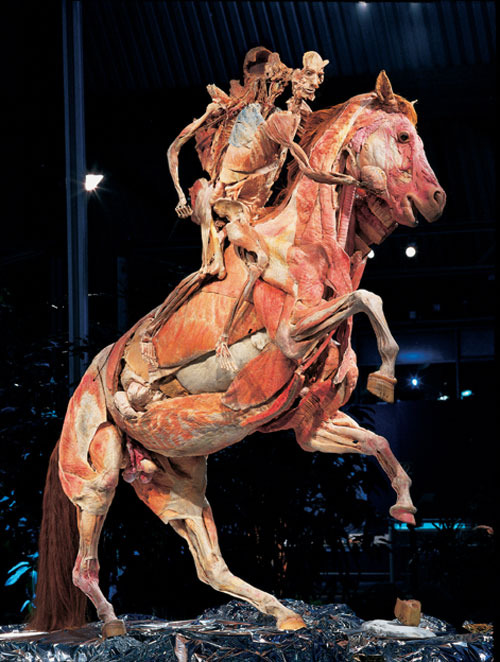
Insight into the anatomy of the surface -

Microscopic view of the ice surface - immersive and detailed look into what creates the surface/ exterior of something that can result in more beauty shining from beneath
Environment - The circumstances, objects, or conditions by which a person or more is surrounded by - country, buildings, nature, situations etc but also can mean the complex of physical, chemical, and biotic factors (such as climate, soil, and living things) that act upon an organism or an ecological community and ultimately determine its form and survival.



Palettes and Patterns - The range of colours used by a particular artist or in a particular picture that uses a repeated decorative design - some artists stick to one set of colours as their ‘trademark colours’ often playing around with the similar patterns but re arranging them with the use of layering, geometry and colour order. In other occasions patterns/ colour palettes would be often repeated and used with in a certain time period - e.g. the 80′s with lots of bold, colourful, crazy and detailed patterns- mainly found on clothing



Identity - Identity is who you are, the way you think about yourself, the way you are viewed by the world and the characteristics that define you. An example is a person's name or the traditional characteristics of an American. It can showcase the way people want to live their life as an individual, making it their own through self expression. It can also relate to people loosing themselves and detreating
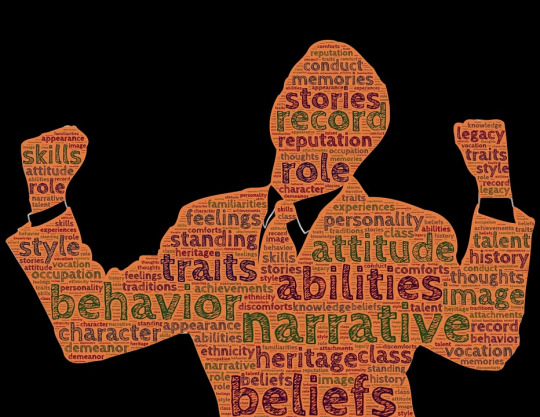


Revolution - a sudden. complete or fundamental change in political organization - government or ruler and the substitution of another by the governed. It can also mean the activity or movement designed to effect fundamental changes in or about situations.
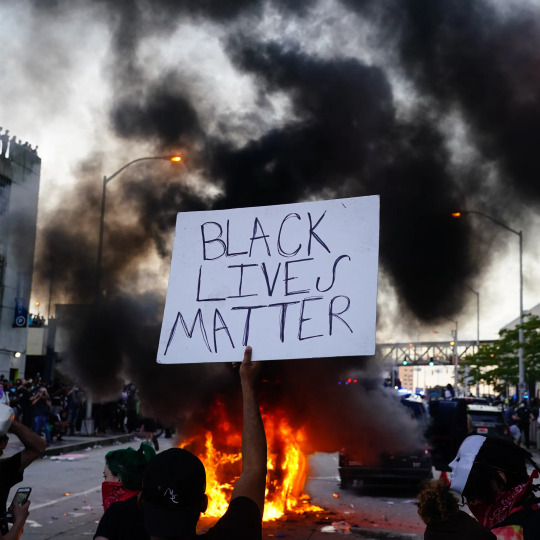
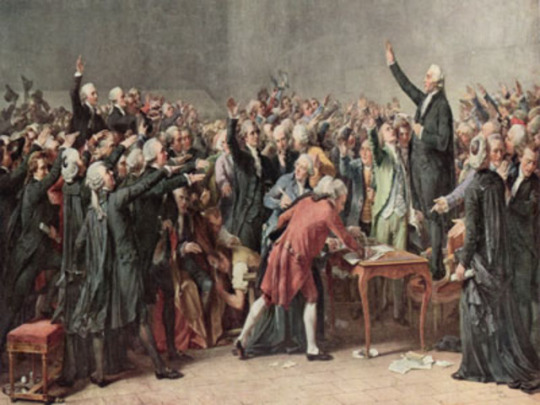
Interior/ Exterior - Interior commonly refers to the inside of something. E.G. An auditorium inside a Theatre or place that lies far inland from a coast or border is said to lie in the ‘interior’ of a country. On the other hand, Exterior is part or the surface of an outside appearance. Another example is representation (as on stage or film) of an outdoor scene - a scene filmed outdoors. It hand tie in with the word ‘Surface’ as it can be referred to the exterior of a person - their appearance
.



Urban - It most commonly is in relation to a city. In that sense, the term may refer to as an urban area, geographical area distinct from rural areas. urban culture, the culture of towns and cities.



Renaissance - The Renaissance was an Art period in European history marking the transition from the Middle Ages to modernity and covering the 15th and 16th centuries through paintings, sculptures/ statues as well as style of clothing.
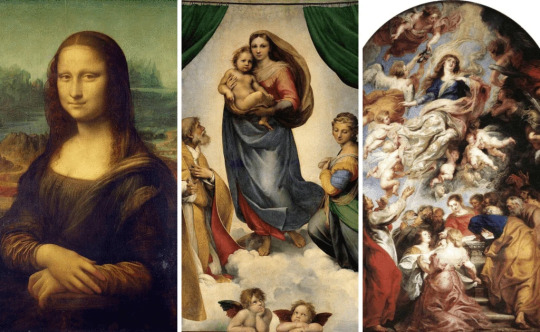
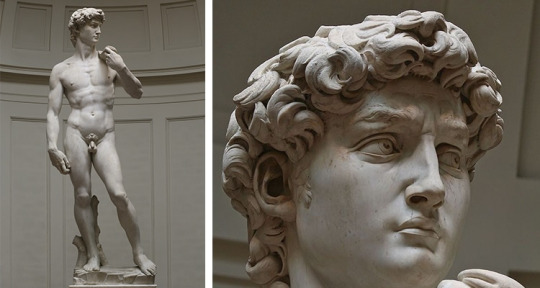

Dystopia - It is an imagined state or society in which there is great suffering or injustice, typically one that is totalitarian or post-apocalyptic. It can branch of into many different situations - Environmental destruction, Nuclear Disaster, Government control, Religious Control, Technological Control, Survival, Loss of Individualism.



Repetition - Repetition is the simple repeating of a word, within a short space of words, with no particular placement of the words to secure emphasis. It can also be used with in art and patterns e.g. wallpaper repeat designs to create interesting and visually exiting arrangements. Repetition is also used in everyday life, people get advice to follow repeatedly to stay strong and keep going everyday. It also can come into terms with an activity of some sort that a person may do over and over again each day - watch tv, eat food, perform in a show etc

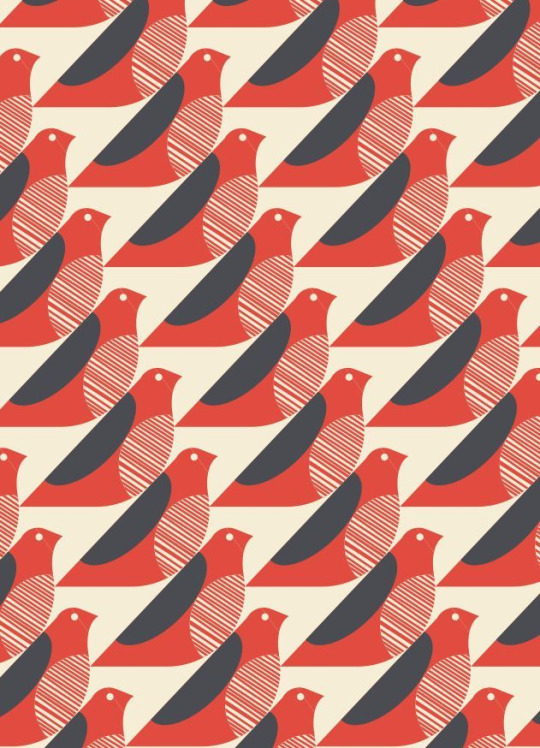
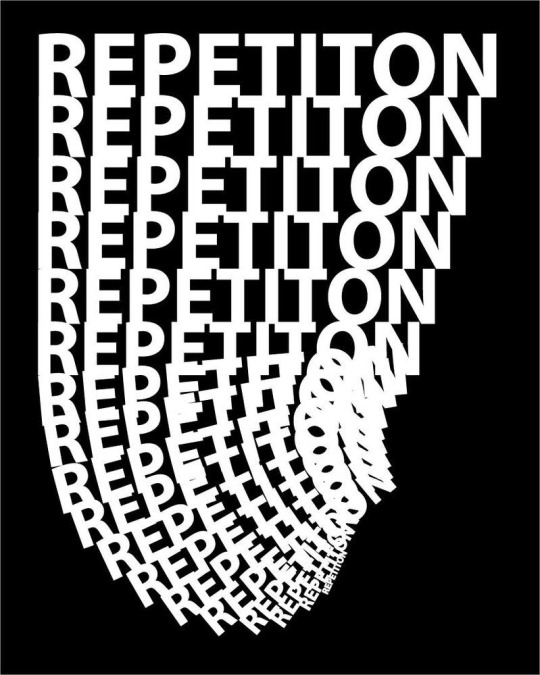
I narrowed my first initial 10 words down to the 5 that I am most keen to use as my theme for my project. I feel with these words, I would be able to come up with some interesting ideas and exiting outcomes.
Surface
Palettes and Patterns
Identity
Interior/ Exterior
Environment
Week 1 Evaluation
Media, skills, processes and techniques - Evaluative section on – Media, skills, processes and techniques that were used/explored – what was learnt – how wide ranging research informed this - and how these met the purpose of the proposal? First section – your planning, themes, specialism and how you have been working.
During this week I used the internet and my blog to research and present the first lot of work for my project. This gave me a look into different topics and words to look into to see what sparked my interests and could potentially be one of the words I pick for my theme/ concept for this project.
Purpose/ theme/concept – Evaluative section on the FMP development – the thought processes – the struggle to solve a problem the journey of change and learning – why decisions were made and for what purpose - what is the point/function of the work?. How the FMP could be further developed in ambitious and innovative ways?
The main goal this week in regards to FMP development was to explore the different avenues that I could take my project down and what I personally am starting to feel that could then lead me onto ideas etc.
One of the main themes that appealed to me the most is the ‘Patterns and Palettes’. I feel like this could be a really interesting route for me to go down and reminds me of the work im familiar working with - the word pattern reminds me of the sewing patterns and fabric designs i work with - on the other hand, the palette portion reminded me of the different use of colour combinations and look to a garment/ costume whether that be as a whole or a specific detailed section. This then led me on to having the idea of creating some form of garment that I could incorporate the patterns throughout the surface of the outcome.
What are you planning for next week? – How and what are you doing?
I am really keen on the whole garment design idea with the incorporation of the patterns and palettes so i am going to create a couple of rough designs experimenting with colour schemes and patterns. I will also include visual inspiration collages from ideas that inspire me to create my outcome as well as looking into colour palettes and what colour combinations compliment each other.
Further Research - Looking into style of garments
To get a further insight into the different style of garments created, I decided to look at some of the best garments/ dresses from the Oscars awards ceremony. This is one of the biggest events to happen every year and always a place to see fresh, new and visually exiting outfits.
The first look that appealed to my taste was from 1982 where Debbie Allen was seen in a white, fully embellished slit fit dress. Although it a moderately simple dress, the fully embellished work on the piece as a whole takes it to another level of ‘Glam’ which is what I feel I am going into the direction for my creation.
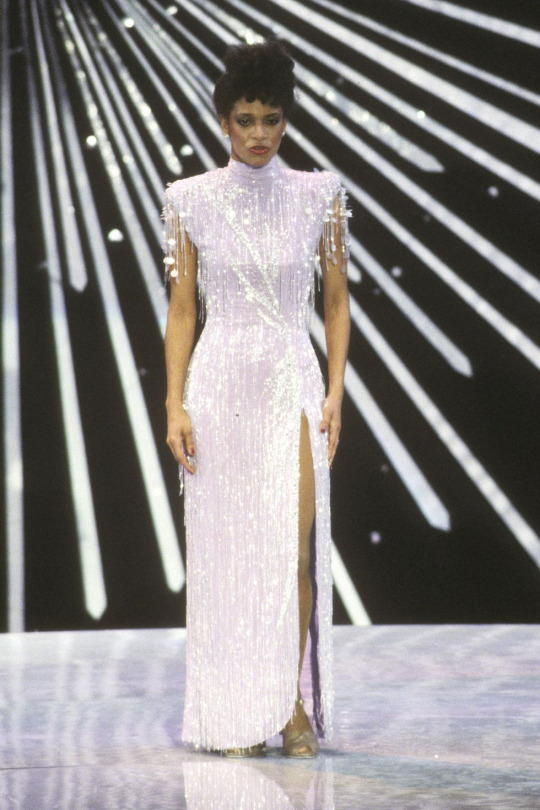
Another garment that was embellished and very fitting with one of my chosen themes ‘Patterns and Pallets’ is this gorgeous embellished pattern dress worn by Jessica Chastain in 2013. Its very clear to see that the garment has many different pattern panels which creates such a stunning yet striking look as a whole but not overwhelming. I feel like this is my inspiration to move forward for my project and what i envision something similar to be as my final outcome.

One of the more plain, simple but effective looks that I saw was a black lace and tulle fit and flare garment worn by Jenifer Lawrence in 2016. There is something really beautiful about the simplicity of the dress but also still feel very detailed with the design through the lace and pleats of tulle. I love the way the subtle lace top portion of the bodice gradually blends into the more elaborate bottom half of the dress. Again, this style is something id love to incorporate and maybe embellish the top lace part with beads and crystals so it would be coherent with the fully beaded bottom portion of some sort.

Lastly, one of my other favourites was a beautiful and simple shaped garment with 3D flower elements cascading all over the dress which was worn by Kate Blanchett in 2016. The 3D appliques add such a creative and almost artsy/ crafty style to the gorgeous simplicity of the dress creating a beautiful floral image to look at. This could protentional give me inspiration to add other 3D elements besides just the beads and crystals.

1 note
·
View note
Text
THE MEGA RP PLOTTING SHEET / MEME. First and foremost, recall that no one is perfect, we all have witnessed some plotting once which did not went too well, be it because of us or our partner. So here have this, which may help for future plotting. It’s a lot! Yes, but perhaps give your partners some insight? Anyway BOLD what fully applies, italicize if only somewhat Mun Name: Phoenix (Pho) (can also be called blaze-bc of my discord username. though i use that name for a oc) Age: 17 (18 in august) Contact: Discord, ims
Character(s) I rp: Aizen,grimmjow, Uryuu, renji, Byakuya, Kusaka, Hanataro Which muse(s) inspires you the most atm?(for MM): Aizen, Grimmjow, Byakuya and Uryuu Current Fandom(s): Bleach, fullmetal alchemist, Yugioh Fandom(s) you have an AU for: Fullmetal alchemist : Brother hood, Yugioh My language(s): English, spanish //Kinda- im learning it// Themes I’m interested in for rp: Fantasy / Science fiction / Horror / Western / Romance / Thriller / Mystery / Dystopia / Adventure / Modern / Erotic / Crime / Mythology / Classic / History / Renaissance / Medieval / Ancient / War / Family / Politics / Religion / School / Adulthood / Childhood / Apocalyptic / Gods / Sport / Music / Science / Fights / Angst / Smut / Drama / etc. Themes/Genres you have an AU for: Modern.
Preferred Thread length: one-liner / 1 para / 2 para / 3+ / novella. Asks can be send by: Mutuals / Non-Mutuals / Personals / Anons. Can Asks be continued?: YES / NO only by Mutuals?: YES / NO. Preferred thread type: crack / casual nothing too deep / serious / deep as heck. Is realism / research important for you in certain themes?: YES / NO. Are you atm open for new plots?: YES / NO / DEPENDS. Do you handle your draft / ask - count well?: YES / NO / SOMEWHAT. How long do you usually take to reply?: 24h / 1 week / 2 weeks / 3+ / months / years. I’m okay with interacting: original characters / a relative of my character (an oc) / duplicates / my fandom / crossovers / multi-muses / self-inserts / people with no AU verse for my fandom / canon-divergent portrayals / au-versions (as main or only verse). Do you post more ic or ooc?: IC / OOC. Are you selective with following others?: YES / NO / DEPENDS.
Best ways to approach you for rp/plotting: message me either on ims or discord. ^^ I am open up to any idea that you may have What expectations do you hold towards your plotting partner: Uh knowing what muse they want to interact ahead of time. Normally I can create a plot if they already know what Muse they want to rp with. How do you usually plot with others, do you give input or leave most work towards your partner?: I say it kinda 50/50 I tried to build the plot equally with the rp partner.
When a partner drops the thread, do you wish to know?: YES / NO / DEPENDS. - And why?: I know some things happen- so its okay if you don’t want to tell me if you are- I normally figure it out after weeks of not responding. (Unless you are a low activity blog- then i figure you are just busy ^^) - Will you tell your partner?: YES / NO / DEPENDS.
Is communication in the rpc important to you? YES / NO. - And why?: Because communication is important, especially for plots we are winging mostly. and if they have any questions about how i portray a certain character. - Are you okay with absolute honesty, even if it may means hearing something negative about you and/or portrayal?: I wanna say Yes. It really depends- If its about me. I want to know why you say that especially if you don’t know me well and we could possibly clear up a misunderstanding or something. But if it for a character Yea sure. As long as it done explaining what they don’t like on it or if there is something I could improve. - Do you think you can handle such situation in a mature way? YES / NO.
Why do you rp again, is there a goal?: to explore my muses and expand on the more complex ones. (Like Aizen for example) Wishlist, be it plots or scenarios: TYBW stuff. more Pendulum arc stuff for Aizen. Muken Aizen related things. What Type of Starters do you prefer / dislike, can’t work with?: I can work with basically any type of starters? As long as it has a clear way to make interaction happen.
What type of characters catch your interest the most?: Characters i’m familiar with. Characters that is well done (Especially Oc’s). What type of characters catch your interest the least?: Characters that seem way to Mary or gary sue. (More Oc related things). Characters who are just- evil because they can be.
What are your strong aspects as rp partner?: willing to learn about different fandoms. Open to literally anything. gets invested in ships easily. What are your weak aspects as rp partner?: Being to anxious to communicate. Forgetfulness. Loosing track of threads (Because threadtracker hates me-) Do you rp smut?: YES / NO. Do you prefer to go into detail?: YES / NO / DEPENDS. Are you okay with black curtain?: YES / NO. - When do you rp smut? More out of fun or character development?: I don’t rp smut. - Anything you would not want to rp there?: N/A Are ships important to you?: YES / NO.
Would you say your blog is ship-focused?: YES / NO
.Do you use read more?: YES / NO / SOMETIMES.
Are you: Multi-Ship / Single-Ship / Dual-Ship — Multiverse / Singleverse.
- What do you love to explore the most in your ships?: Relationship building. Having moments that can be expanded on between the characters. Having relationship conflict. Even know i don’t rp smut- There is so much that can explored with ships that is more then just sex related things.
- What is your smut tag?: N/A
Are you okay with pre-established relationships?: YES / NO. - And what kind of ones?: Familial, Friendship.
► SECTION ABOUT YOUR MUSE.

//you said to pick my favorite muse- so here we go xD// - What could possibly make your Muse interesting towards others, why should they rp with this particular character of yours now, what possible plots do they offer?: Oh jeez- he is the main villian of the series. One of the most unpredictable muses that I have. Possible plots- depends on the time line. If its in the pendulum era. Literally anything can happen. There is a large gap of time (9 years) of things that could of happen but the anime or manga didn’t show. The same goes with his Captain era. We don’t really see much then or anything relating to his time in Muken. There is a lot of different situations that could happen with the right other muse.
- With what type of Muses do you usually struggle to rp with?: muses who are hopelessely romantics. muses who don’t have much to work with in a plot. - With what type of Muses do they usually work well with?: muses who has similar mind set as him or could be as unpredictable. . Characters that could possibly catch him off guard or catch his interest because of the way they act.
- What interests your Muse(s) in general: evolution, Science related things. hollowification experimenting. becoming a god. - What do they desire, is their goal?: Their goal . It depends most verses its to gain access to the royal realm and become the one true god, and change the soul society. - What catches their interest first when meeting someone new?: The way that they handle them selves, there intentional personally. - What do they value in a person?: Loyalty. Hard working. - What themes do they like talking about?: he likes when people talk about themselves. He can learn more about them. But he also likes talking philsophical debates about existence and morals. Or anything that would relate to his mindset about life. - Which themes bore them?: anything to romantic. He does not like that. like full on fliriting. He doesn’t do at all.
- Did they ever went through something traumatic?: Yes //though it can be debated what is consider traumatic to a adult who causes there own trauma mostly// //But like- he had to have seen some stuff in his childhood that would make him more desensitize to murder and killing fellow Shinigami// - What could possibly trigger them?: Experiencing the feeling of dying. Sensory deprivation. //after his 20,000 years in Muken. Which is underground. away from most sounds and sights and feeling// - What could set them off, enrage them?: Making him question his motives. Making him actually feel something. making him loose his goals.
- Is there someone /-thing they hate?: Urahara, Shinji. - Is there someone /-thing they love?: //Romantically- in most verses no// Platonically : Hiyori (only in pendulum arc). Hougyoku. his self.
Is your Muse easy to approach?: YES / NO. - Best ways to approach them?: catch their attention. Literally just talk to him. don’t go trying to challenge or question his ego. Literally just talk to him with any amount of respect . depending on the verse- his responses may very. but other then that- He is rather easy to approach depending on your intentions to be approaching him. - Where are they usually to find?: His office in division five, hueco mondo, (Specifically in Los Noches), Muken. The forest near rukongai (only really applies to pendulum verse).
Something you may still want to point out about your muse?: he is nerd with a god complex. he deserves a more flesh out back story then what the Manga gave him. I try to keep him as close to the manga, keeping all of the things that happen in the manga and anime as canon. Only changing his child hood and early divisions days- as that isn’t really shown and expanding his relationships with some of the visoreds. I also portray him as Aro/ace in most verses so its very Awkward if you try to ship with him in most verses unless discussed in ims or discord. tagged by @skyvar //thank you for the tag snow uwu// tagging @rukia-kuchiki-divided @redeyeschaosdragon @kaibacorpbros (any bro) @viciousvizard @hirako5hinji @bookofaion @gentleshinigami @goofyshinigami @windstormwielding @cxb3r @nightbeat-cat @world-duelists / @loyal-to-chaos (if you want ^^) and you! if you want to do this uwu.
9 notes
·
View notes
Photo
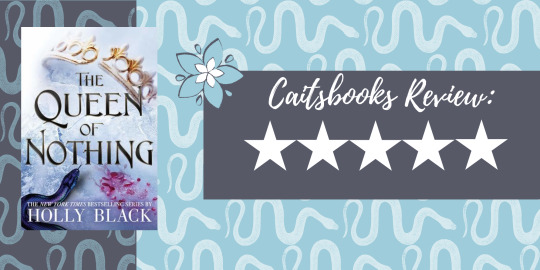
THE QUEEN OF NOTHING (THE FOLK OF THE AIR #3) BY HOLLY BLACK – DID IT SURVIVE THE HYPE? (REVIEW)
This Review Will Contain Spoilers for The Cruel Prince and The Wicked King, but there will be NO SPOILERS for The Queen of Nothing. I’m not cruel.
Overall: 5/5 Stars Characters: 5/5 Setting: 5/5 Writing: 5/5 Plot and Themes: 5/5 Awesomeness Factor: 5/5 Review in a Nutshell: Listen, I’m trash for this series. The Queen of Nothing had a lot to live up to, but it did. It reminded me why this series is so hyped, it proved it deserves every bit of it.
“Let me be feared and never again afraid.”
--------------------------------------------------------------------------------------------------------
// Content Warning: Violence, Death, Assault, Child Abuse/Neglect, War Themes, Murder //
Release Date: 11/19/2019 Publisher: Little, Brown Books for Young Readers Page Count: 309 Premise:
The Wicked King left off with the worst possible cliffhanger ending, with a plot twist I never saw coming. The Queen of Nothing takes place not too long after that ending- Jude has created a life for herself in the mortal world after being exiled, doing odd jobs for other Folk and living with Vivi and Oak. When her sister Taryn returns from Elfhame with shocking news, Jude must delve back into the world of courtly politics and war to help her, even if it means facing the man who betrayed her, the High King Cardan Greenbriar.
“Two paths are before me, but only one leads to victory.”
--------------------------------------------------------------------------------------------------------
Read more for all of my thoughts on the conclusion to The Folk of the Air series, or, check out the full review over on my blog!!
[ Related: The Wicked King by Holly Black (ARC Review) ]
Follow Me Here: Blog || Goodreads || Bookstagram || Twitter || Reviews
--------------------------------------------------------------------------------------------------------
“We have lived in our armor for so long, you and I. And now I am not sure if either of us knows how to remove it.”
WRITING & SETTING
Holly Black’s writing style is just amazing. Her writing perfectly balancing poignancy and thought-provoking topics with fun quips and just amazingly relatable moments. Jude is of both the mortal world and the magical world- being a mortal raised in Elfhame- and you can get that feeling just through Holly Black’s writing. It feels both otherworldly and magical while being full of purely human aspects.
Meanwhile, the setting really makes this series stand out. Holly Black truly is the queen of the Fae. She has crafted a beautifully intricate world parallel to ours, with such great depth and detail, and grounded in fascinating mythology and history. While The Queen of Nothing doesn’t expand on the world and magic quite as much as previous books have, it really does place a spotlight on it.
“Magic is seldom so convenient as to conform to our preferences.”
PLOT
I won’t lie- some of this book feels a little rushed. That’s honestly a complaint I have with the series as a whole. Each book could be much longer than they are. The Queen of Nothing comes in at just barely over 300 pages, and it has a lot to wrap up. That said, it does succeed. While I did wish we could have a little more time to sit with some moments, the fast pace did make this book very bingeable and absolutely impossible to put down.
This book also has a few twists thrown in, but they definitely weren’t quite as surprising as the twists in previous books. There was maybe one that really took me by surprise, but the rest were fairly predictable if you are highly invested with this series and as obsessed as I am. That said, this book is still a great conclusion. It ties up loose ends really well, but it definitely wasn’t as… surprising as I expected. I don’t know how else to say it without spoilers. It just didn’t end in a way I thought the series would end.
“If you’re looking for reasons why he disappointed you, by all accounts, Prince Cardan was a disappointment from the beginning.”
mood.
CHARACTERS
The characters are where The Folk of the Air series really does shine. Every aspect of this series is fantastic, don’t get me wrong, but it’s the characters that add the heart and brutality to the series. Jude is such a strong and interesting protagonist. This book puts her through a lot, and we see sides of her that were hinted at in previous books fully explored. I reread the first two books in preparation for this one and damn, her growth is astonishing. Also, Cardan. I love Cardan so much. He’s a drunk idiot sometimes, but other times, he is just plain incredible. We definitely see that incredible side of him a lot in this book. It’s truly amazing for a character to be so understood by the reader while also still being able to surprise them.
However, I don’t want to go too much into Cardan right now because, well, spoilers. Let’s talk about some of our other characters- Vivi and Heather are my loves and I would love an entire book just about them. Taryn didn’t really leave that much of an impression on me in this book beyond the first fifty pages, but she definitely made a mark in those pages. And finally, Madoc. Madoc is such a captivating character- I always think I have him pinned down but then he does something to completely change my perspective of him. This book continues to reveal sides of him I both expected yet didn’t and I absolutely loved it.
“I know how to drive a knife through my own hand. I know how to hate and be hated. And I know how to win the day, provided I am willing to sacrifice everything good in me for it.”
--------------------------------------------------------------------------------------------------------
[ Related: The Cruel Prince by Holly Black (ARC Review) ]
--------------------------------------------------------------------------------------------------------
CONCLUSION
Pros- Great characters, solid conclusion, I love this world Cons- A little rushed. I’m also just bitter that this series is over. What am I supposed to obsess over now??? Overall- 5/5 stars. This book series will forever have a hold on my heart, and The Queen of Nothing reminded me of every reason why. This book is a fantastic conclusion to a series I’ll love for the rest of my life.
“Let me have everything I ever wanted, everything I ever dreamed, and eternal misery along with it. Let me live on with an ice shard through my” heart.
--------------------------------------------------------------------------------------------------------
IF YOU LIKED THE QUEEN OF NOTHING, I’D RECOMMEND:
An Enchantment of Ravens by Margaret Rogerson – (Review)
Wicked Saints (Something Dark and Holy #1) by Emily A. Duncan – (Review)
The Caged Queen (Iskari #2) by Kristen Ciccarelli – (Review + Giveaway)
--------------------------------------------------------------------------------------------------------
Have you read The Queen of Nothing yet? What did you think?
Also, what are your thoughts on the cover? After reading, I get all the symbolism, but I’m still not really a fan of it (especially the Barnes and Noble edition- oh god please don’t make me look at it).
--------------------------------------------------------------------------------------------------------
Add To Your Goodreads Shelf Purchase From: Amazon, Barnes and Noble, Indiebound
Looking for more reviews & other bookish nonsense? Follow Me Here: Blog || Goodreads || Bookstagram || Twitter || Reviews
--------------------------------------------------------------------------------------------------------
BONUS! MORE QUOTES THAT I LOVE
“‘Mortals are fragile,’ I say. ‘Not you,’ he says in a way that sounds a little like a lament. ‘You never break.’”
“By you, I am forever undone.”
“It really is a magical word: no. You say whatever bullshit you want and I just say no.”
“I think of his riddle. How do people like us take off our armor? One piece at a time.”
“My sweet nemesis, how glad I am that you returned.”
“That boy is your weakness.”
“All power is cursed. The most terrible among us will do anything to get it, and those who’d wield power best don’t want it thrust upon them. But that doesn’t mean they can avoid their responsibilities forever.”
“There is no banquet too abundant for a starving man.”
“Imagine if, in the mortal world, a lawyer passed the bar by killing another lawyer.”
“‘I tried to kill you,’ she reminds me. ‘You’ve described pretty much every important relationship in my life.’”
#qon#tqon#tcp#the queen of nothing#queen of nothing#tfota#twk#the folk of the air#the cruel prince#the wicked king#the queen of nothing review#holly black#jude duarte#cardan greenbriar#books#book#booklr#bookblr#bookish#bookstagram#review#book review#elfhame#caitsbooks reviews
10 notes
·
View notes